Chart Types in Xamarin Charts (SfChart)
6 Jan 202524 minutes to read
Line Chart
To render a Xamarin Line chart, create an instance of LineSeries and add to the Series collection property of SfChart. You can use the following properties to customize the appearance.
-
Color– used to change the color of the line. -
Opacity- used to control the transparency of the chart series. -
StrokeWidth– used to change the stroke width of the line.
<chart:SfChart>
...
<chart:LineSeries ItemsSource ="{Binding Data}" XBindingPath="Year"
YBindingPath="Value"/>
</chart:SfChart>SfChart chart = new SfChart();
...
LineSeries lineSeries = new LineSeries()
{
ItemsSource = Data,
XBindingPath = "Year",
YBindingPath = "Value"
};
chart.Series.Add(lineSeries);
NOTE
You can also explore our Xamarin Line Chart example to know how to represent time-dependent data, showing trends in data at equal intervals.
Dashed Lines
StrokeDashArray property of the LineSeries is used to render line series with dashes.
<chart:LineSeries ItemsSource ="{Binding Data}" XBindingPath="Month" YBindingPath="Value">
<chart:LineSeries.StrokeDashArray>
<x:Array Type="{x:Type x:Double}">
<sys:Double>5</sys:Double>
<sys:Double>6</sys:Double>
</x:Array>
</chart:LineSeries.StrokeDashArray>
</chart:LineSeries>LineSeries lineSeries = new LineSeries()
{
ItemsSource = Data,
XBindingPath = "Month",
YBindingPath = "Value"
};
lineSeries.StrokeDashArray = new double[2] { 5, 6 };
chart.Series.Add(lineSeries);Fast Line Chart
FastLineSeries is a line chart, but it loads faster than LineSeries. You can use this when there are large number of points to be loaded in chart. To render a fast line chart, create an instance of FastLineSeries and add to the Series collection property of SfChart. You can use the following properties to customize the fast line segment appearance.
-
Color– used to change the color of the series. -
Opacity- used to control the transparency of the chart series. -
StrokeWidth– used to change the stroke width of the series.
<chart:SfChart>
...
<chart:FastLineSeries ItemsSource ="{Binding Data}" XBindingPath="XValue" YBindingPath="YValue"/>
</chart:SfChart>SfChart chart = new SfChart();
...
FastLineSeries fastLineSeries = new FastLineSeries()
{
ItemsSource = Data,
XBindingPath = "XValue",
YBindingPath = "YValue"
};
chart.Series.Add(fastLineSeries);
Dashed Lines
StrokeDashArray property of the FastLineSeries is used to render fast line series with dashes.
[C#]
FastLineSeries fastLineSeries = new FastLineSeries()
{
ItemsSource = Data,
XBindingPath = "Month",
YBindingPath = "Value"
};
fastLineSeries.StrokeDashArray = new double[2] { 2, 3 };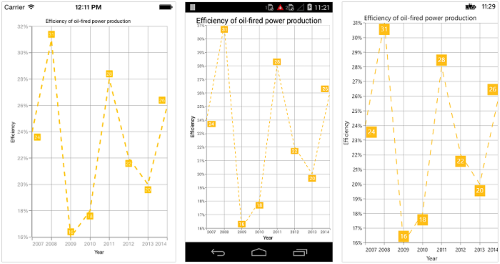
EnableAntiAliasing
Since FastLineSeries can be loaded with a large number of points, the rendering of series should be smooth. This requirement can be achieved by setting EnableAntiAliasing property of FastLineSeries as false.
Stacked Line Chart
To render a stacked line chart, create an instance of StackingLineSeries and add to the Series collection property of SfChart. You can use the following properties to customize the stacked line appearance.
-
Color– used to change the color of the line. -
StrokeWidth– used to change the stroke width of the line. -
Opacity- used to control the transparency of the chart series.
<chart:SfChart>
...
<chart:StackingLineSeries ItemsSource ="{Binding Data1}" XBindingPath="XValue" YBindingPath="YValue"/>
<chart:StackingLineSeries ItemsSource ="{Binding Data2}" XBindingPath="XValue" YBindingPath="YValue"/>
<chart:StackingLineSeries ItemsSource ="{Binding Data3}" XBindingPath="XValue" YBindingPath="YValue"/>
<chart:StackingLineSeries ItemsSource ="{Binding Data4}" XBindingPath="XValue" YBindingPath="YValue"/>
</chart:SfChart>SfChart chart = new SfChart();
...
StackingLineSeries stackingLineSeries1 = new StackingLineSeries()
{
ItemsSource = Data1,
XBindingPath = "XValue",
YBindingPath = "YValue"
};
StackingLineSeries stackingLineSeries2 = new StackingLineSeries()
{
ItemsSource = Data2,
XBindingPath = "XValue",
YBindingPath = "YValue"
};
StackingLineSeries stackingLineSeries3 = new StackingLineSeries()
{
ItemsSource = Data3,
XBindingPath = "XValue",
YBindingPath = "YValue"
};
StackingLineSeries stackingLineSeries4 = new StackingLineSeries()
{
ItemsSource = Data4,
XBindingPath = "XValue",
YBindingPath = "YValue"
};
chart.Series.Add(stackingLineSeries1);
chart.Series.Add(stackingLineSeries2);
chart.Series.Add(stackingLineSeries3);
chart.Series.Add(stackingLineSeries4);Dashed Stacked Lines
StrokeDashArray property of the StackingLineSeries is used to render stacked line series with dashes.
[C#]
StackingLineSeries stackingLineSeries1 = new StackingLineSerie()
{
ItemsSource = Data1,
XBindingPath = "XValue",
YBindingPath = "YValue"
};
stackingLineSeries1.StrokeDashArray = new double[2] { 13, 4 };
StackingLineSeries stackingLineSeries2 = new StackingLineSerie()
{
ItemsSource = Data1,
XBindingPath = "XValue",
YBindingPath = "YValue"
};
stackingLineSeries2.StrokeDashArray = new double[2] { 13, 4 };
StackingLineSeries stackingLineSeries3 = new StackingLineSerie()
{
ItemsSource = Data1,
XBindingPath = "XValue",
YBindingPath = "YValue"
};
stackingLineSeries3.StrokeDashArray = new double[2] { 13, 4 };
StackingLineSeries stackingLineSeries4 = new StackingLineSerie()
{
ItemsSource = Data1,
XBindingPath = "XValue",
YBindingPath = "YValue"
};
stackingLineSeries4.StrokeDashArray = new double[2] { 13, 4 };100% Stacked Line Chart
To render a 100% stacked line chart, create an instance of StackingLine100Series and add to the Series collection property of SfChart. You can use the following properties to customize the series appearance.
-
Color– used to change the color of the line. -
StrokeWidth– used to change the stroke width of the line. -
Opacity- used to control the transparency of the chart series. -
StrokeDashArray- used to change the dashes of the stacked line series.
<chart:SfChart>
...
<chart:StackingLine100Series ItemsSource ="{Binding Data1}" XBindingPath="XValue" YBindingPath="YValue"/>
<chart:StackingLine100Series ItemsSource ="{Binding Data2}" XBindingPath="XValue" YBindingPath="YValue"/>
<chart:StackingLine100Series ItemsSource ="{Binding Data3}" XBindingPath="XValue" YBindingPath="YValue"/>
<chart:StackingLine100Series ItemsSource ="{Binding Data4}" XBindingPath="XValue" YBindingPath="YValue"/>
</chart:SfChart>SfChart chart = new SfChart();
...
StackingLine100Series stackingLine100Series1 = new StackingLine100Series()
{
ItemsSource = Data1,
XBindingPath = "XValue",
YBindingPath = "YValue"
};
StackingLine100Series stackingLine100Series2 = new StackingLine100Series()
{
ItemsSource = Data2,
XBindingPath = "XValue",
YBindingPath = "YValue"
};
StackingLine100Series stackingLine100Series3 = new StackingLine100Series()
{
ItemsSource = Data3,
XBindingPath = "XValue",
YBindingPath = "YValue"
};
StackingLine100Series stackingLine100Series4 = new StackingLine100Series()
{
ItemsSource = Data4,
XBindingPath = "XValue",
YBindingPath = "YValue"
};
chart.Series.Add(stackingLine100Series1);
chart.Series.Add(stackingLine100Series2);
chart.Series.Add(stackingLine100Series3);
chart.Series.Add(stackingLine100Series4);Area Chart
To render an Xamarin Area Chart, create an instance of AreaSeries and add to the Series collection property of SfChart. You can use the following properties to customize the appearance.
-
Color– used to change the color of the series. -
Opacity- used to control the transparency of the chart series. -
StrokeWidth– used to change the stroke width of the series. -
StrokeColor– used to change the stroke color of the series.
<chart:SfChart>
...
<chart:AreaSeries ItemsSource ="{Binding Data}" XBindingPath="Year"
YBindingPath="Value"/>
</chart:SfChart>SfChart chart = new SfChart();
...
AreaSeries areaSeries = new AreaSeries()
{
ItemsSource = Data,
XBindingPath = "Year",
YBindingPath = "Value"
};
chart.Series.Add(areaSeries);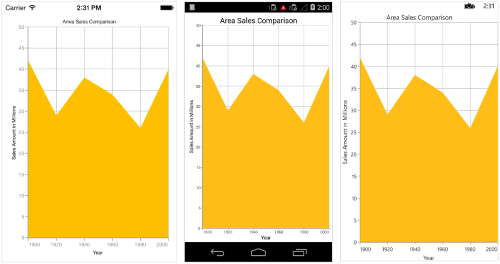
NOTE
You can also explore our Xamarin Area Chart example to knows how to represent time-dependent data, showing trends in data at equal intervals.
Spline Area Chart
To render a Xamarin Spline Area chart, create an instance of SplineAreaSeries and add to the Series collection property of SfChart. You can use the following properties to customize the spline area appearance.
-
Color– used to change the color of the series. -
Opacity- used to control the transparency of the chart series. -
StrokeWidth– used to change the stroke width of the series. -
StrokeColor– used to change the stroke color of the series.
<chart:SfChart>
...
<chart:SplineAreaSeries ItemsSource ="{Binding Data}" XBindingPath="Year"
YBindingPath="Value"/>
</chart:SfChart>SfChart chart = new SfChart();
...
SplineAreaSeries splineAreaSeries = new SplineAreaSeries()
{
ItemsSource = Data,
XBindingPath = "Year",
YBindingPath = "Value"
};
chart.Series.Add(splineAreaSeries);
NOTE
You can also explore our Xamarin Spline Area Chart example to knows how to represent time-dependent data and show trends in data at equal intervals.
Spline Rendering Types
SplineType allows you to change the spline area curve in series.
The following types are used in SplineAreaSeries as
By default SplineType value is Natural.
The following code shows how to set the SplineType value as Cardinal
<chart:SfChart>
...
<chart:SplineAreaSeries ItemsSource ="{Binding Data}" XBindingPath="Month"
YBindingPath="Value" SplineType="Cardinal" />
</chart:SfChart>SfChart chart = new SfChart();
...
SplineAreaSeries splineAreaSeries = new SplineAreaSeries()
{
ItemsSource = Data,
XBindingPath = "Month",
YBindingPath = "Value",
SplineType = SplineType.Cardinal
};
chart.Series.Add(splineAreaSeries);Step Area Chart
To render a Step Area chart, create an instance of StepAreaSeries and add to the Series collection property of SfChart. You can use the following properties to customize the appearance.
-
Color- used to change the color of the series. -
Opacity- used to control the transparency of the chart series. -
StrokeWidth- used to change the stroke width of the series. -
StrokeColor- used to change the stroke color of the series.
<chart:SfChart>
...
<chart:StepAreaSeries ItemsSource ="{Binding Data}" XBindingPath="Year"
YBindingPath="Value"/>
</chart:SfChart>SfChart chart = new SfChart();
...
StepAreaSeries stepAreaSeries = new StepAreaSeries()
{
ItemsSource = Data,
XBindingPath = "Year",
YBindingPath = "Value"
};
chart.Series.Add(stepAreaSeries);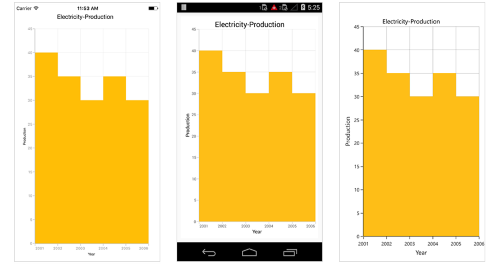
Range Area Chart
To render a Xamarin Range Area chart, create an instance of RangeAreaSeries and add to the Series collection property of SfChart.
Since the RangeAreaSeries requires two Y values for a point, your data should contain high and low values. High and low value specifies the maximum and minimum range of the point.
There are two ways you can provide data to range area chart,
1.You can use ChartDataPoint's three parameter constructor to pass XValue, High and Low values to RangeAreaSeries,
[C#]
SfChart chart = new SfChart();
...
ObservableCollection<ChartDataPoint> data = new ObservableCollection<ChartDataPoint>()
{
new ChartDataPoint("Jan/10", 30, 18),
new ChartDataPoint("Feb/10", 24, 12),
new ChartDataPoint("Mar/10", 29, 15),
new ChartDataPoint("Apr/10", 24, 10),
new ChartDataPoint("May/10", 30, 18),
new ChartDataPoint("Jun/10", 24, 10),
};
RangeAreaSeries rangeAreaSeries = new RangeAreaSeries()
{
ItemsSource = data
};
chart.Series.Add(rangeAreaSeries);2.Or else you can use High and Low properties of RangeAreaSeries to map the high and low values from custom object to chart.
<chart:SfChart>
...
<chart:SfChart.Series>
<chart:RangeAreaSeries ItemsSource="{Binding RangeAreaData}" XBindingPath="Name" High="High" Low="Low"/>
</chart:SfChart.Series>
</chart:SfChart>SfChart chart = new SfChart();
...
RangeAreaSeries rangeAreaSeries = new RangeAreaSeries()
{
ItemsSource = RangeAreaData,
XBindingPath = "Name",
High = "High",
Low = "Low"
};
chart.Series.Add(rangeAreaSeries);You can use the following properties to customize the appearance.
-
Color– used to change the color of the series. -
Opacity- used to control the transparency of the chart series. -
StrokeWidth– used to change the stroke width of the series. -
StrokeColor– used to change the stroke color of the series.
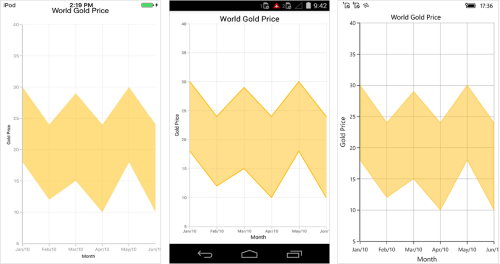
NOTE
You can also explore our Xamarin Range Area Chart example to know how to show variations in the data values for a given time.
Spline Range Area Chart
To render a Xamarin Spline Range Area chart, create an instance of the SplineRangeAreaSeries, and add that instance to the Series collection property of SfChart.
Since the SplineRangeAreaSeries requires two Y values for a point, data should contain high and low values. The high and low values specify the maximum and minimum ranges of a point.
The data can be provided to a spline range area chart by using the following two ways:
1.Using the ChartDataPoint’s three parameter constructor to pass XValue, High, and Low values to the SplineRangeAreaSeries.
[C#]
SfChart chart = new SfChart();
...
ObservableCollection<ChartDataPoint> data = new ObservableCollection<ChartDataPoint>()
{
new ChartDataPoint("Jan", 30, 18),
new ChartDataPoint("Feb", 24, 12),
new ChartDataPoint("Mar", 29, 15),
new ChartDataPoint("Apr", 24, 10),
new ChartDataPoint("May", 30, 18),
new ChartDataPoint("Jun", 24, 10),
};
SplineRangeAreaSeries splineRangeAreaSeries = new SplineRangeAreaSeries()
{
ItemsSource = data
};
chart.Series.Add(splineRangeAreaSeries);2.Or else, using the high and low properties of SplineRangeAreaSeries to map the high and low values from custom object to chart.
<chart:SfChart>
...
<chart:SfChart.Series>
<chart:SplineRangeAreaSeries ItemsSource="{Binding SplineRangeAreaData}" XBindingPath="Name" High="High" Low="Low"/>
</chart:SfChart.Series>
</chart:SfChart>SfChart chart = new SfChart();
...
SplineRangeAreaSeries splineRangeAreaSeries = new SplineRangeAreaSeries()
{
ItemsSource = SplineRangeAreaData,
XBindingPath = "Name",
High = "High",
Low = "Low"
};
chart.Series.Add(splineRangeAreaSeries);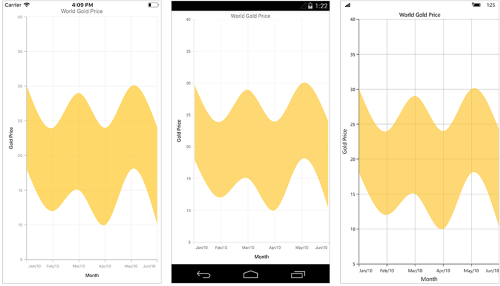
NOTE
You can also explore our Xamarin Spline Range Area Chart example to knows how to display continuous data points as a set of splines that vary between high and low values.
Spline Rendering Types
SplineType property allows you to change the spline range area curve in series.
The following types can be used for SplineRangeAreaSeries
- Natural
- Monotonic
- Cardinal
- Clamped
By default SplineType value is Natural.
The following code shows how to set the SplineType value as Cardinal.
<chart:SfChart>
…
<chart:SplineRangeAreaSeries ItemsSource="{Binding SplineRangeAreaData}" XBindingPath="Name" High="High" Low="Low" SplineType="Cardinal"/>
</chart:SfChart>SplineRangeAreaSeries splineRangeAreaSeries = new SplineRangeAreaSeries
{
ItemsSource = SplineRangeAreaData,
XBindingPath = "Name",
High = "High",
Low = "Low",
SplineType = SplineType.Cardinal
};
chart.Series.Add(splineRangeAreaSeries);Stacked Area Chart
To render a Xamarin Stacked Area chart, create an instance of StackingAreaSeries and add to the Series collection property of SfChart. You can use the following properties to customize the stacked area appearance.
-
Color– used to change the color of the series. -
Opacity- used to control the transparency of the chart series. -
StrokeWidth– used to change the stroke width of the series. -
StrokeColor– used to change the stroke color of the series.
<chart:SfChart>
...
<chart:StackingAreaSeries ItemsSource ="{Binding Data1}" XBindingPath="Year"
YBindingPath="Value"/>
<chart:StackingAreaSeries ItemsSource ="{Binding Data2}" XBindingPath="Year"
YBindingPath="Value"/>
<chart:StackingAreaSeries ItemsSource ="{Binding Data3}" XBindingPath="Year"
YBindingPath="Value"/>
</chart:SfChart>SfChart chart = new SfChart();
...
StackingAreaSeries stackingAreaSeries1 = new StackingAreaSeries()
{
ItemsSource = Data1,
XBindingPath = "Year",
YBindingPath = "Value"
};
StackingAreaSeries stackingAreaSeries2 = new StackingAreaSeries()
{
ItemsSource = Data2,
XBindingPath = "Year",
YBindingPath = "Value"
};
StackingAreaSeries stackingAreaSeries3 = new StackingAreaSeries()
{
ItemsSource = Data3,
XBindingPath = "Year",
YBindingPath = "Value"
};
chart.Series.Add(stackingAreaSeries1);
chart.Series.Add(stackingAreaSeries2);
chart.Series.Add(stackingAreaSeries3);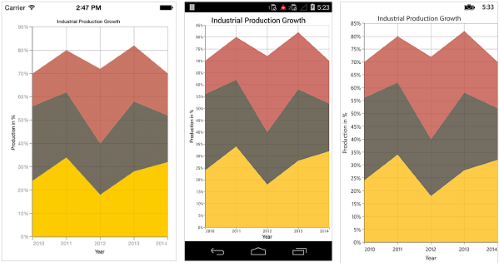
NOTE
You can also explore our Xamarin Stacked Area Chart example to knows how to visualizes data with y-values stacked one over another in a series order.
100% Stacked Area Chart
To render a Xamarin.Forms 100% Stacked Area chart, create an instance of StackingArea100Series and add to the Series collection property of SfChart. You can use the following properties to customize the 100% stacked area appearance.
-
Color– used to change the color of the series. -
Opacity- used to control the transparency of the chart series. -
StrokeWidth– used to change the stroke width of the series. -
StrokeColor– used to change the stroke color of the series.
<chart:SfChart>
...
<chart:StackingArea100Series ItemsSource ="{Binding Data1}" XBindingPath="Year"
YBindingPath="Value"/>
<chart:StackingArea100Series ItemsSource ="{Binding Data2}" XBindingPath="Year"
YBindingPath="Value"/>
<chart:StackingArea100Series ItemsSource ="{Binding Data3}" XBindingPath="Year"
YBindingPath="Value"/>
</chart:SfChart>SfChart chart = new SfChart();
...
StackingArea100Series stackingArea100Series1 = new StackingArea100Series()
{
ItemsSource = Data1,
XBindingPath = "Year",
YBindingPath = "Value"
};
StackingArea100Series stackingArea100Series2 = new StackingArea100Series()
{
ItemsSource = Data2,
XBindingPath = "Year",
YBindingPath = "Value"
};
StackingArea100Series stackingArea100Series3 = new StackingArea100Series()
{
ItemsSource = Data3,
XBindingPath = "Year",
YBindingPath = "Value"
};
chart.Series.Add(stackingArea100Series1);
chart.Series.Add(stackingArea100Series2);
chart.Series.Add(stackingArea100Series3);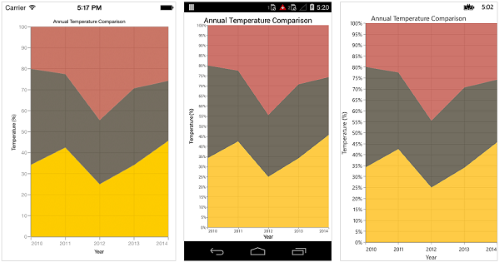
NOTE
You can also explore our Xamarin.Forms Stacked Area 100% Chart example to knows how to displays multiple series of data as stacked areas, ensuring that the cumulative proportion of each stacked element always totals 100%.
Column Chart
To render a Xamarin Column Chart, create an instance of ColumnSeries and add to the Series collection property of SfChart. You can use the following properties to customize the appearance.
-
Color– used to change the color of the series. -
Opacity- used to control the transparency of the chart series. -
StrokeWidth– used to change the stroke width of the series. -
StrokeColor– used to change the stroke color of the series. -
CornerRadius- used to add the rounded corners to the rectangle. TheTopLeft,TopRight,BottomLeftandBottomRightofChartCornerRadiusproperties are used to set the radius value for each corner. -
DataMarkerPosition- used to position the data marker atBottom,TopandCenterof the rectangle. -
Spacing- used to change the spacing between two segments. The default value of spacing is 0, and the value ranges from 0 to 1. Here, 1 and 0 correspond to 100% and 0% of the available space, respectively. -
Width- used to change the width of the rectangle. The default value of the width is 0.8, and the value ranges from 0 to 1. Here, 1 and 0 correspond to 100% and 0% of the available width, respectively.
<chart:SfChart>
...
<chart:ColumnSeries ItemsSource ="{Binding Data}" XBindingPath="Country"
YBindingPath="Value"/>
</chart:SfChart>SfChart chart = new SfChart();
...
ColumnSeries columnSeries = new ColumnSeries()
{
ItemsSource = Data,
XBindingPath = "Country",
YBindingPath = "Value"
};
chart.Series.Add(columnSeries);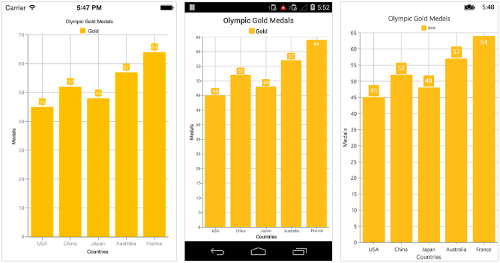
NOTE
You can also explore our Xamarin Column Chart example how to create a column chart with data labels and customize its appearance with built-in color palette.
Overlapped placement
By default, all the column series which has the same x and y axes are placed side by side in a chart. If you want place the series one over the other (overlapped), set the SideBySideSeriesPlacement property of SfChart to false and configure the Width property to differentiate the series. The following code snippet and screenshot illustrate the overlapped placement of column series.
<chart:SfChart x:Name="Chart" SideBySideSeriesPlacement="False" >
. . .
<chart:SfChart.Series>
<chart:ColumnSeries ItemsSource="{Binding Data1}" Label="2014" XBindingPath="Month" YBindingPath="Year2014">
</chart:ColumnSeries>
<chart:ColumnSeries Width="0.5" ItemsSource="{Binding Data2}" Label="2015" XBindingPath="Month" YBindingPath="Year2015" >
</chart:ColumnSeries>
</chart:SfChart.Series>
. . .
</chart:SfChart>SfChart chart = new SfChart()
{
SideBySideSeriesPlacement = false
};
chart.PrimaryAxis = new CategoryAxis();
chart.SecondaryAxis = new NumericalAxis();
ColumnSeries series1 = new ColumnSeries()
{
ItemsSource = view.Data1,
XBindingPath = "Month",
YBindingPath = "Year2014"
};
ColumnSeries series2 = new ColumnSeries()
{
ItemsSource = view.Data2,
XBindingPath = "Month",
YBindingPath = "Year2015",
Width="0.5"
};
chart.Series.Add(series1);
chart.Series.Add(series2);
Histogram Chart
To render a Xamarin Histogram chart, create an instance of HistogramSeries, and add it to the series collection of SfChart.
Histogram chart provides a visual display of large amount of data that are difficult to understand in a tabular or data grid form.
You can customize intervals using the Interval property and collapse the normal distribution curve using the ShowNormalDistributionCurve property. You can use the following properties to customize the appearance.
-
Color– used to change the color of the series. -
StrokeWidth– used to change the stroke width of the series. -
StrokeColor– used to change the stroke color of the series. -
CurveColor– used to change the color of the normal distribution curve. -
DataMarkerPosition- used to position the data marker at Bottom, Top and Center of the rectangle.
<chart:SfChart>
...
<chart:HistogramSeries ItemsSource ="{Binding Data}" XBindingPath="XValue"
YBindingPath="YValue" Interval="20"/>
</chart:SfChart>SfChart chart = new SfChart();
...
HistogramSeries histogramSeries = new HistogramSeries()
{
ItemsSource = Data,
XBindingPath = "XValue",
YBindingPath = "YValue",
Interval = 20
};
chart.Series.Add(histogramSeries);
NOTE
You can also explore our Xamarin Histogram Chart example to know how to represent time-dependent data, showing trends in data at equal intervals.
Range Column Chart
To render a Xamarin Range Column chart, create an instance of RangeColumnSeries and add to the Series collection property of SfChart.
Since the RangeColumnSeries requires two Y values for a point, your data should contain high and low values. High and low value specifies the maximum and minimum range of the point.
There are two ways you can provide data to RangeColumn chart,
1.You can use ChartDataPoint's three parameter constructor to pass XValue, High and Low values to RangeColumnSeries,
[C#]
SfChart chart = new SfChart();
...
ObservableCollection<ChartDataPoint> data = new ObservableCollection<ChartDataPoint>()
{
new ChartDataPoint("Jan", 7.6, 1.8),
new ChartDataPoint("Feb", 10, 3),
new ChartDataPoint("Mar", 7.5, 1.7),
new ChartDataPoint("Apr", 7.8, 4.5),
new ChartDataPoint("May", 11.4, 5),
new ChartDataPoint("Jun", 10.1, 4.2),
};
RangeColumnSeries rangeColumnSeries = new RangeColumnSeries()
{
ItemsSource = data
};
chart.Series.Add(rangeColumnSeries);2.Or else you can use High and Low properties of RangeColumnSeries to map the high and low values from custom object to chart.
<chart:SfChart>
...
<chart:RangeColumnSeries ItemsSource ="{Binding Data}"
XBindingPath="Month"
High="Value1"
Low="Value2"/>
</chart:SfChart>SfChart chart = new SfChart();
...
RangeColumnSeries rangeColumnSeries = new RangeColumnSeries()
{
ItemsSource = Data,
XBindingPath = "Month",
High = "Value1",
Low = "Value2"
};
chart.Series.Add(rangeColumnSeries);Following properties are used to customize the range column segment appearance,
-
Color– used to change the color of the series. -
Opacity- used to control the transparency of the chart series. -
StrokeWidth– used to change the stroke width of the series. -
StrokeColor– used to change the stroke color of the series. -
CornerRadius- used to add the rounded corners to the rectangle. TheTopLeft,TopRight,BottomLeftandBottomRightofChartCornerRadiusproperties are used to set the radius value for each corner. -
Spacing- used to change the spacing between two segments. The default value of spacing is 0, and the value ranges from 0 to 1. Here, 1 and 0 correspond to 100% and 0% of the available space, respectively. -
Width- used to change the width of the rectangle. The default value of the width is 0.8, and the value ranges from 0 to 1. Here, 1 and 0 correspond to 100% and 0% of the available width, respectively.
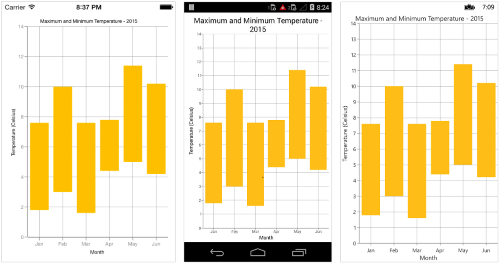
NOTE
You can also explore our Xamarin Range Column Chart example to knows how to display a range of data by plotting two y-values per data point.
Stacked Column Chart
To render a Stacked Column chart, create an instance of StackingColumnSeries and add to the Series collection property of SfChart. You can use the following properties to customize the stacked column segment appearance.
-
Color– used to change the color of the series. -
Opacity- used to control the transparency of the chart series. -
StrokeWidth– used to change the stroke width of the series. -
StrokeColor– used to change the stroke color of the series. -
CornerRadius- used to add the rounded corners to the rectangle. TheTopLeft,TopRight,BottomLeftandBottomRightofChartCornerRadiusproperties are used to set the radius value for each corner. -
DataMarkerPosition- used to position the data marker atBottom,TopandCenterof the rectangle. -
Spacing- used to change the spacing between two segments. The default value of spacing is 0, and the value ranges from 0 to 1. Here, 1 and 0 correspond to 100% and 0% of the available space, respectively. -
Width- used to change the width of the rectangle. The default value of the width is 0.8, and the value ranges from 0 to 1. Here, 1 and 0 correspond to 100% and 0% of the available width, respectively.
<chart:SfChart>
...
<chart:StackingColumnSeries ItemsSource ="{Binding Data1}" XBindingPath="Month"
YBindingPath="Value"/>
<chart:StackingColumnSeries ItemsSource ="{Binding Data2}" XBindingPath="Month"
YBindingPath="Value"/>
<chart:StackingColumnSeries ItemsSource ="{Binding Data3}" XBindingPath="Month"
YBindingPath="Value"/>
</chart:SfChart>SfChart chart = new SfChart();
...
StackingColumnSeries stackingColumnSeries1 = new StackingColumnSeries()
{
ItemsSource = Data1,
XBindingPath = "Month",
YBindingPath = "Value"
};
StackingColumnSeries stackingColumnSeries2 = new StackingColumnSeries()
{
ItemsSource = Data2,
XBindingPath = "Month",
YBindingPath = "Value"
};
StackingColumnSeries stackingColumnSeries3 = new StackingColumnSeries()
{
ItemsSource = Data3,
XBindingPath = "Month",
YBindingPath = "Value"
};
chart.Series.Add(stackingColumnSeries1);
chart.Series.Add(stackingColumnSeries2);
chart.Series.Add(stackingColumnSeries3);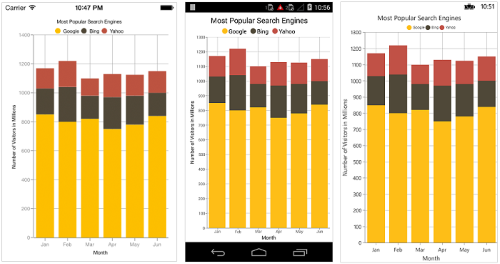
100% Stacked Column Chart
To render a 100% Stacked Column chart, create an instance of StackingColumn100Series and add to the Series collection property of SfChart. You can use the following properties to customize the series appearance.
-
Color– used to change the color of the series. -
Opacity- used to control the transparency of the chart series. -
StrokeWidth– used to change the stroke width of the series. -
StrokeColor– used to change the stroke color of the series. -
CornerRadius- used to add the rounded corners to the rectangle. TheTopLeft,TopRight,BottomLeftandBottomRightofChartCornerRadiusproperties are used to set the radius value for each corner. -
DataMarkerPosition- used to position the data marker atBottom,TopandCenterof the rectangle. -
Spacing- used to change the spacing between two segments. The default value of spacing is 0, and the value ranges from 0 to 1. Here, 1 and 0 correspond to 100% and 0% of the available space, respectively. -
Width- used to change the width of the rectangle. The default value of the width is 0.8, and the value ranges from 0 to 1. Here, 1 and 0 correspond to 100% and 0% of the available width, respectively.
<chart:SfChart>
...
<chart:StackingColumn100Series ItemsSource ="{Binding Data1}" XBindingPath="Year"
YBindingPath="Value"/>
<chart:StackingColumn100Series ItemsSource ="{Binding Data2}" XBindingPath="Year"
YBindingPath="Value"/>
<chart:StackingColumn100Series ItemsSource ="{Binding Data3}" XBindingPath="Year"
YBindingPath="Value"/>
</chart:SfChart>SfChart chart = new SfChart();
...
StackingColumn100Series stackingColumn100Series1 = new StackingColumn100Series()
{
ItemsSource = Data1,
XBindingPath = "Year",
YBindingPath = "Value"
};
StackingColumn100Series stackingColumn100Series2 = new StackingColumn100Series()
{
ItemsSource = Data2,
XBindingPath = "Year",
YBindingPath = "Value"
};
StackingColumn100Series stackingColumn100Series3 = new StackingColumn100Series()
{
ItemsSource = Data3,
XBindingPath = "Year",
YBindingPath = "Value"
};
chart.Series.Add(stackingColumn100Series1);
chart.Series.Add(stackingColumn100Series2);
chart.Series.Add(stackingColumn100Series3);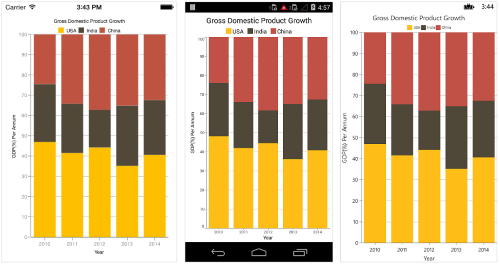
Bar Chart
To render a Xamarin Bar Chart, create an instance of BarSeries and add to the Series collection property of SfChart. You can use the following properties to customize the bar segment appearance.
-
Color– used to change the color of the series. -
Opacity- used to control the transparency of the chart series. -
StrokeWidth– used to change the stroke width of series. -
StrokeColor– used to change the stroke color of the series. -
CornerRadius- used to add the rounded corners to the rectangle. TheTopLeft,TopRight,BottomLeftandBottomRightofChartCornerRadiusproperties are used to set the radius value for each corner. -
DataMarkerPosition- used to position the data marker at left, right and center of the rectangle. -
Spacing- used to change the spacing between two segments. The default value of spacing is 0, and the value ranges from 0 to 1. Here, 1 and 0 correspond to 100% and 0% of the available space, respectively. -
Width- used to change the width of the rectangle. The default value of the width is 0.8, and the value ranges from 0 to 1. Here, 1 and 0 correspond to 100% and 0% of the available width, respectively.
<chart:SfChart>
...
<chart:BarSeries ItemsSource ="{Binding Data}" XBindingPath="Year"
YBindingPath="Value"/>
</chart:SfChart>SfChart chart = new SfChart();
...
BarSeries barSeries = new BarSeries ()
{
ItemsSource = Data,
XBindingPath = "Year",
YBindingPath = "Value"
};
chart.Series.Add(barSeries);
NOTE
You can also explore our Xamarin Bar Chart example to compare values across categories by using horizontal bars.
Stacked Bar Chart
To render a Stacked Bar chart, create an instance of StackingBarSeries and add to the Series collection property of SfChart. You can use the following properties to customize the stacked bar segment appearance.
-
Color– used to change the color of the series. -
Opacity- used to control the transparency of the chart series. -
StrokeWidth– used to change the stroke width of the series. -
StrokeColor– used to change the stroke color of the series. -
CornerRadius- used to add the rounded corners to the rectangle. TheTopLeft,TopRight,BottomLeftandBottomRightofChartCornerRadiusproperties are used to set the radius value for each corner. -
DataMarkerPosition- used to position the data marker at left, right and center of the rectangle. -
Spacing- used to change the spacing between two segments.The default value of spacing is 0 and the value ranges from 0 to 1. Here 1 and 0 corresponds to 100% and 0% of available space respectively. -
Width- used to change the width of the rectangle. The default value of width is 0.8 and the value ranges from 0 to 1. Here 1 and 0 corresponds to 100% and 0% of available width respectively.
<chart:SfChart>
...
<chart:StackingBarSeries ItemsSource ="{Binding Data1}" XBindingPath="Month"
YBindingPath="Value"/>
<chart:StackingBarSeries ItemsSource ="{Binding Data2}" XBindingPath="Month"
YBindingPath="Value"/>
<chart:StackingBarSeries ItemsSource ="{Binding Data3}" XBindingPath="Month"
YBindingPath="Value"/>
</chart:SfChart>SfChart chart = new SfChart();
...
StackingBarSeries stackingBarSeries1 = new StackingBarSeries()
{
ItemsSource = Data1,
XBindingPath = "Month",
YBindingPath = "Value"
};
StackingBarSeries stackingBarSeries2 = new StackingBarSeries()
{
ItemsSource = Data2,
XBindingPath = "Month",
YBindingPath = "Value"
};
StackingBarSeries stackingBarSeries3 = new StackingBarSeries()
{
ItemsSource = Data3,
XBindingPath = "Month",
YBindingPath = "Value"
};
chart.Series.Add(stackingBarSeries1);
chart.Series.Add(stackingBarSeries2);
chart.Series.Add(stackingBarSeries3);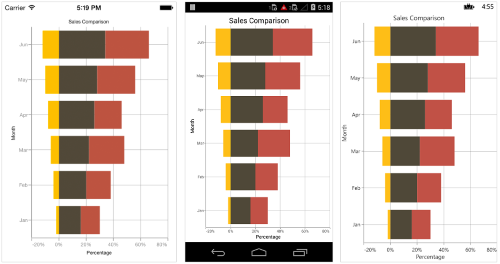
100% Stacked Bar Chart
To render a Xamarin 100% Stacked Bar chart, create an instance of StackingBar100Series and add to the Series collection property of SfChart. You can use the following properties to customize the series appearance.
-
Color– used to change the color of the series. -
Opacity- used to control the transparency of the chart series. -
StrokeWidth– used to change the stroke width of the series. -
StrokeColor– used to change the stroke color of the series. -
CornerRadius- used to add the rounded corners to the rectangle. TheTopLeft,TopRight,BottomLeftandBottomRightofChartCornerRadiusproperties are used to set the radius value for each corner. -
DataMarkerPosition- used to position the data marker at left, right and center of the rectangle. -
Spacing- used to change the spacing between two segments.The default value of spacing is 0 and the value ranges from 0 to 1. Here 1 and 0 corresponds to 100% and 0% of available space respectively. -
Width- used to change the width of the rectangle. The default value of width is 0.8 and the value ranges from 0 to 1. Here 1 and 0 corresponds to 100% and 0% of available width respectively.
<chart:SfChart>
...
<chart:StackingBar100Series ItemsSource ="{Binding Data1}" XBindingPath="Year"
YBindingPath="Value"/>
<chart:StackingBar100Series ItemsSource ="{Binding Data2}" XBindingPath="Year"
YBindingPath="Value"/>
<chart:StackingBar100Series ItemsSource ="{Binding Data3}" XBindingPath="Year"
YBindingPath="Value"/>
</chart:SfChart>SfChart chart = new SfChart();
...
StackingBar100Series stackingBar100Series1 = new StackingBar100Series()
{
ItemsSource = Data1,
XBindingPath = "Year",
YBindingPath = "Value"
};
StackingBar100Series stackingBar100Series2 = new StackingBar100Series()
{
ItemsSource = Data2,
XBindingPath = "Year",
YBindingPath = "Value"
};
StackingBar100Series stackingBar100Series3 = new StackingBar100Series()
{
ItemsSource = Data3,
XBindingPath = "Year",
YBindingPath = "Value"
};
chart.Series.Add(stackingBar100Series1);
chart.Series.Add(stackingBar100Series2);
chart.Series.Add(stackingBar100Series3);
NOTE
You can also explore our Xamarin Stacked Bar 100% Chart example to knows how to displays multiple series of data as stacked bars.
Spline Chart
To render a Xamarin Spline chart, create an instance of SplineSeries and add to the Series collection property of SfChart. You can use the following properties to customize the spline segment appearance.
-
Color– used to change the color of the series. -
Opacity- used to control the transparency of the chart series. -
StrokeWidth– used to change the stroke width of the series.
<chart:SfChart>
...
<chart:SplineSeries ItemsSource ="{Binding Data}" XBindingPath="Month"
YBindingPath="Value"/>
</chart:SfChart>SfChart chart = new SfChart();
...
SplineSeries splineSeries = new SplineSeries()
{
ItemsSource = Data,
XBindingPath = "Month",
YBindingPath = "Value"
};
chart.Series.Add(splineSeries);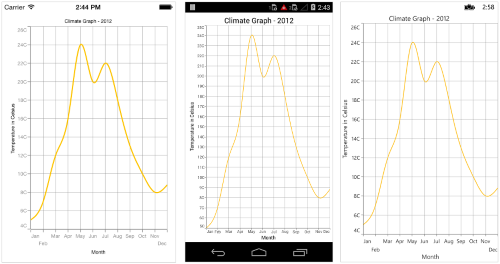
NOTE
You can also explore our Xamarin Spline Chart example to knows how to connecting the data points with straight lines.
Dashed Lines
StrokeDashArray property of the SplineSeries is used to render spline series with dashes.
<chart:SplineSeries ItemsSource ="{Binding Data}" XBindingPath="Month" YBindingPath="Value">
<chart:SplineSeries.StrokeDashArray>
<x:Array Type="{x:Type x:Double}">
<sys:Double>5</sys:Double>
<sys:Double>6</sys:Double>
</x:Array>
</chart:SplineSeries.StrokeDashArray>
</chart:SplineSeries>SplineSeries splineSeries = new SplineSeries()
{
ItemsSource = Data,
XBindingPath = "Month",
YBindingPath = "Value"
};
splineSeries.StrokeDashArray = new double[2] { 5, 6 };
chart.Series.Add(splineSeries);Spline Rendering Types
SplineType allows you to change the spline curve in series.
The following types are used in SplineSeries as
- Natural
- Monotonic
- Cardinal
- Clamped
By default SplineType value is Natural.
The following code shows how to set the SplineType value as Cardinal
<chart:SfChart>
...
<chart:SplineSeries ItemsSource ="{Binding Data}" XBindingPath="Month"
YBindingPath="Value" SplineType="Cardinal" />
</chart:SfChart>SfChart chart = new SfChart();
...
SplineSeries splineSeries = new SplineSeries()
{
ItemsSource = Data,
XBindingPath = "Month",
YBindingPath = "Value",
SplineType = SplineType.Cardinal
};
chart.Series.Add(splineSeries);
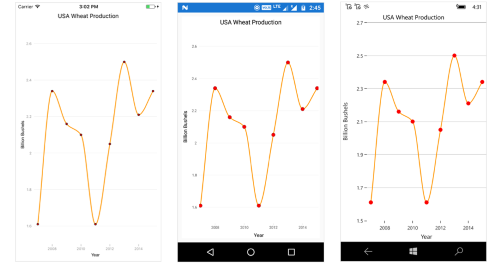
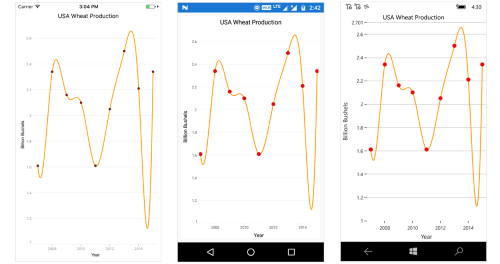
Step Line Chart
To render a Step Line chart, create an instance of StepLineSeries and add to the Series collection property of
SfChart. You can use the following properties to customize the spline segment appearance.
-
Color– used to change the color of the series. -
Opacity- used to control the transparency of the chart series. -
StrokeWidth– used to change the stroke width of the series.
<chart:SfChart.Series>
<chart:StepLineSeries ItemsSource="{Binding Data}" XBindingPath="Month"
YBindingPath="Value" />
</chart:SfChart.Series>SfChart chart = new SfChart();
...
StepLineSeries stepLine = new StepLineSeries()
{
ItemsSource = Data,
XBindingPath = "Month",
YBindingPath = "Value"
};
chart.Series.Add(stepLine);
Bubble Chart
To render a Xamarin Bubble Chart, create an instance of BubbleSeries and add to the Series collection property of SfChart.
Bubble chart requires 3 fields (X, Y and Size) to plot a point. Here Size is used to specify the size of each bubble segment.
There are two ways you can provide data to bubble chart,
1.You can use ChartDataPoint’s three parameter constructor to pass XValue, YValue and Size values to BubbleSeries,
[C#]
SfChart chart = new SfChart();
...
ObservableCollection<ChartDataPoint> data = new ObservableCollection<ChartDataPoint>()
{
new ChartDataPoint(64, 14.4, 20),
new ChartDataPoint(71, 2, 15),
new ChartDataPoint(74, 7, 30),
new ChartDataPoint(80, 4, 22),
new ChartDataPoint(82, 10.3, 28),
new ChartDataPoint(94, 1, 8),
new ChartDataPoint(96, 6, 18),
new ChartDataPoint(98, 12.3, 28),
};
BubbleSeries bubbleSeries = new BubbleSeries()
{
ItemsSource = data
};
chart.Series.Add(bubbleSeries);2.Or else you can use YBindingPath and Size properties of BubbleSeries to map the Y value and size from custom object to chart.
<chart:SfChart>
...
<chart:BubbleSeries ItemsSource ="{Binding Data}"
XBindingPath="XValue"
YBindingPath="YValue"
Size="Size"/>
</chart:SfChart>SfChart chart = new SfChart();
...
BubbleSeries bubbleSeries = new BubbleSeries()
{
ItemsSource = Data,
XBindingPath = "XValue",
YBindingPath = "YValue",
Size = "Size”
};
chart.Series.Add(bubbleSeries);Following properties are used to customize the bubble segment appearance.
-
Color– used to change the color of the series. -
Opacity- used to control the transparency of the chart series. -
StrokeWidth– used to change the stroke width of the series. -
StrokeColor– used to change the stroke color of the series. -
MinimumRadius– used to change the minimum size of the series. -
MaximumRadius– used to change the maximum size of the series.
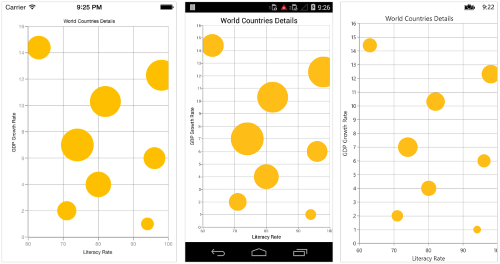
Show zero size bubbles
The zero size bubble segments can be enabled or disabled by using the ShowZeroSizeBubbles property. The default value of ShowZeroSizeBubbles property value is true.
<chart:SfChart.Series>
...
<chart:BubbleSeries ShowZeroSizeBubbles = "True"/>
</chart:SfChart>SfChart chart = new SfChart();
...
BubbleSeries bubbleSeries = new BubbleSeries()
{
ShowZeroSizeBubbles = true;
};
chart.Series.Add(bubbleSeries);
The following code example and screenshots describes when ShowZeroSizeBubbles value is false.
<chart:SfChart.Series>
...
<chart:BubbleSeries ShowZeroSizeBubbles = "False"/>
</chart:SfChart>SfChart chart = new SfChart();
...
BubbleSeries bubbleSeries = new BubbleSeries()
{
ShowZeroSizeBubbles = false;
};
chart.Series.Add(bubbleSeries);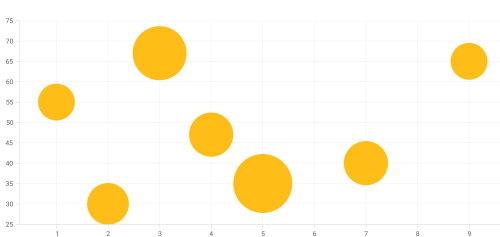
NOTE
You can also explore our Xamarin Bubble Chart example to knows how to render and configure the bubble type charts
Scatter Chart
To render a Xamarin Scatter chart, create an instance of ScatterSeries and add to the Series collection property of SfChart. You can use the following properties to customize the scatter segment appearance.
-
Color– used to change the color of the series. -
Opacity- used to control the transparency of the chart series. -
StrokeWidth– used to change the stroke width of the series. -
StrokeColor– used to change the stroke color of the series. -
ScatterWidth– used to change the width of the series. -
ScatterHeight– used to change the height of the series. -
ShapeType- used to change the rendering shape of scatter series. The available shapes areCross,Diamond,Ellipse,Hexagon,InvertedTriangle,Pentagon,Plus,RectangleandTriangle.
<chart:SfChart>
...
<chart:ScatterSeries ScatterHeight="15"
ScatterWidth="15"
ShapeType="Ellipse"
ItemsSource ="{Binding Data}"
XBindingPath="Year"
YBindingPath="Value"/>
</chart:SfChart>SfChart chart = new SfChart();
...
ScatterSeries scatterSeries = new ScatterSeries ()
{
ItemsSource = Data,
ScatterHeight = 15,
ScatterWidth = 15,
ShapeType = ChartScatterShapeType.Ellipse,
XBindingPath = "Year",
YBindingPath = "Value"
};
chart.Series.Add(scatterSeries);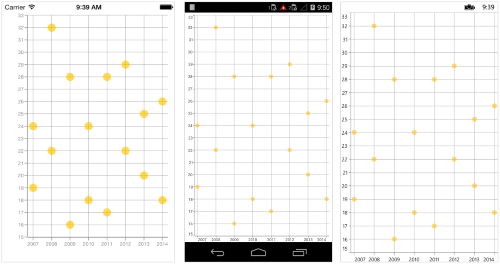
NOTE
You can also explore our Xamarin Scatter Chart example to knows how to represent time-dependent data, showing trends in data at equal intervals.
Fast Scatter Chart
The FastScatterSeries is a special kind of scatter series that renders a collection with a huge number of data points. You can use the following properties to customize the appearance of a fast scatter point.
-
Color– used to change the color of series. -
Opacity– used to control the transparency of chart series. -
StrokeWidth– used to change the stroke width of series. -
StrokeColor– used to change the stroke color of series. -
ScatterWidth– used to change the width of series. -
ScatterHeight– used to change the height of series. -
ShapeType– used to change the rendering shape of fast scatter series. The available shapes areCross,Diamond,Ellipse,Hexagon,InvertedTriangle,Pentagon,Plus,RectangleandTriangle. -
EnableAntiAliasing– Enables or disables the smoothness of series. Default value ofEnableAntiAliasingproperty is true.
<chart:SfChart>
...
<chart:FastScatterSeries ScatterHeight="15"
ScatterWidth="15"
ShapeType="Ellipse"
ItemsSource ="{Binding Data}"
XBindingPath="Year"
YBindingPath="Value"/>
</chart:SfChart>SfChart chart = new SfChart();
...
FastScatterSeries fastScatterSeries = new FastScatterSeries ()
{
ItemsSource = Data,
ScatterHeight = 15,
ScatterWidth = 15,
ShapeType = ChartScatterShapeType.Ellipse,
XBindingPath = "Year",
YBindingPath = "Value"
};
chart.Series.Add(fastScatterSeries);
OHLC Chart
To render an Xamarin OHLC chart, create an instance of HiLoOpenCloseSeries and add to the Series collection property of SfChart.
OHLC chart requires five values (X, Open, High, Low and Close) to plot a point.
There are two ways you can provide data to an OHLC chart,
1.You can use ChartDataPoint's five parameter constructor to pass XValue, Open, High, Low, Close , Volume values to HiLoOpenCloseSeries and technical indicators.
[C#]
SfChart chart = new SfChart();
...
ObservableCollection<ChartDataPoint> data = new ObservableCollection<ChartDataPoint>()
{
new ChartDataPoint("2010", 873.8, 878.85, 855.5, 860.5),
new ChartDataPoint("2011", 861, 868.4, 835.2, 843.45),
new ChartDataPoint("2012", 846.15, 853, 838.5, 847.5),
new ChartDataPoint("2013", 846, 860.75, 841, 855),
new ChartDataPoint("2014", 841, 845, 827.85, 838.65)
};
HiLoOpenCloseSeries hiLoOpenCloseSeries = new HiLoOpenCloseSeries()
{
ItemsSource = data
};
chart.Series.Add(hiLoOpenCloseSeries);2.Or else you can use Open,High,Low and Close properties of HiLoOpenCloseSeries to map Open, High, Low and Close values from custom object to chart.
<chart:SfChart>
...
<chart:HiLoOpenCloseSeries ItemsSource ="{Binding Data}" XBindingPath="Year"
High="Value1" Low="Value2"
Open="Value3" Close="Value4"/>
</chart:SfChart>SfChart chart = new SfChart();
...
HiLoOpenCloseSeries hiLoOpenCloseSeries = new HiLoOpenCloseSeries()
{
ItemsSource = Data,
XBindingPath = "Year",
Open = "Value1",
High = "Value2",
Low = "Value3",
Close = "Value4"
};
chart.Series.Add(hiLoOpenCloseSeries);You can use the following properties to customize the HiLoOpenCloseSeries segment appearance.
-
Color– used to change the color of the series. -
Opacity- used to control the transparency of the chart series. -
StrokeWidth– used to change the stroke width of the series. -
Spacing- used to change the spacing between two segments. -
Width- used to change the width of the rectangle.

NOTE
You can also explore our Xamarin OHLC Chart example to know how to represent time-dependent data, showing trends in data at equal intervals.
Bull and Bear Color
In OHLC chart, BullFillColor property is used to specify a fill color for the segments that indicates an increase in stock price in the measured time interval and BearFillColor property is used to specify a fill color for the segments that indicates a decrease in stock price in the measured time interval.
<chart:HiLoOpenCloseSeries BearFillColor="Blue"
BullFillColor="Purple"
ItemsSource ="{Binding Data}"
XBindingPath="Year"
High="Value1"
Low="Value2"
Open="Value3"
Close="Value4"/>HiLoOpenCloseSeries hiLoOpenCloseSeries = new HiLoOpenCloseSeries()
{
ItemsSource = Data,
XBindingPath = "Year",
Open = "Value1",
High = "Value2",
Low = "Value3",
Close = "Value4",
BearFillColor = Color.Blue,
BullFillColor = Color.Purple
};
Candle Chart
To render a Xamarin Candle Chart, create an instance of CandleSeries and add to the Series collection property of SfChart.
Candle chart requires five values (X, Open, High, Low and Close) to plot a point.
There are two ways you can provide data to an candle chart,
1.You can use ChartDataPoint’s five parameter constructor to pass XValue, Open, High, Low and close values to CandleSeries,
[C#]
SfChart chart = new SfChart();
...
ObservableCollection<ChartDataPoint> data = new ObservableCollection<ChartDataPoint>()
{
new ChartDataPoint("2010", 873.8, 878.85, 855.5, 860.5),
new ChartDataPoint("2011", 861, 868.4, 835.2, 843.45),
new ChartDataPoint("2012", 846.15, 853, 838.5, 847.5),
new ChartDataPoint("2013", 846, 860.75, 841, 855),
new ChartDataPoint("2014", 841, 845, 827.85, 838.65)
};
CandleSeries candleSeries = new CandleSeries ()
{
ItemsSource = data
};
chart.Series.Add(candleSeries);2.Or else you can use Open,High,Low and Close property of CandleSeries to map Open, High, Low and Close values from custom object to chart.
<chart:SfChart>
...
<chart:CandleSeries ItemsSource ="{Binding Data}"
XBindingPath="Year"
High="Value1"
Low="Value2"
Open="Value3"
Close="Value4"/>
</chart:SfChart>SfChart chart = new SfChart();
...
CandleSeries candleSeries = new CandleSeries()
{
ItemsSource = Data,
XBindingPath = "Year",
Open = "Value1",
High = "Value2",
Low = "Value3",
Close = "Value4"
};
chart.Series.Add(candleSeries);You can use the following properties to customize the candle segment appearance.
-
Color– used to change the color of the series. -
Opacity- used to control the transparency of the chart series. -
StrokeWidth– used to change the stroke width of the series. -
StrokeColor– used to change the stroke color of the series.
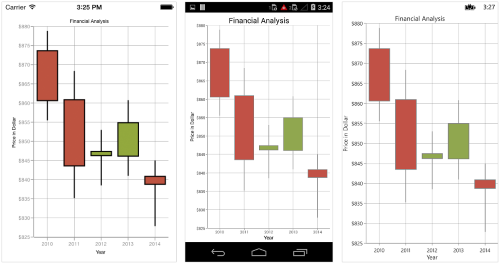
NOTE
You can also explore our Xamarin Candle Chart example to knows how to represent time-dependent data, showing trends in data at equal intervals.
Bull and Bear Color
In Candle chart, BullFillColor property is used to specify a fill color for the segments that indicates an increase in stock price in the measured time interval and BearFillColor property is used to specify a fill color for the segments that indicates a decrease in stock price in the measured time interval.
<chart:CandleSeries BearFillColor="Blue"
BullFillColor="Purple"
ItemsSource ="{Binding Data}"
XBindingPath="Year"
High="Value1"
Low="Value2"
Open="Value3"
Close="Value4" />CandleSeries candleSeries = new CandleSeries()
{
ItemsSource = Data,
XBindingPath = "Year",
Open = "Value1",
High = "Value2",
Low = "Value3",
Close = "Value4",
BearFillColor = Color.Blue,
BullFillColor = Color.Purple
};
EnableSolidCandles
In Candle Series, EnableSolidCandles property is used to specify whether the candle segment should be filled or hollow. The default value of this property is false.
<chart:SfChart>
...
<chart:SfChart.Series>
<chart:CandleSeries ItemsSource="{Binding FinancialData}" EnableSolidCandles="True"/>
</chart:SfChart.Series>
</chart:SfChart>SfChart chart = new SfChart()
{
...
Series =
{
new CandleSeries()
{
ItemsSource = viewModel.FinancialData,
EnableSolidCandles = true,
}
}
};Radar Chart
To render a Xamarin Radar chart, create an instance of RadarSeries and add to the Series collection property of SfChart.
Draw type
DrawType property is used to specify the radar series rendering type. Following are the two options you can set to this property,
-
Line– data points are visualized using line series. -
Area– data points are visualized using area series.
<chart:RadarSeries ItemsSource="{Binding RadarData}" DrawType="Line"
XBindingPath="Name" YBindingPath="Value" />RadarSeries radar = new RadarSeries ();
radar.ItemsSource = viewModel.RadarData;
radar.XBindingPath = "Name";
radar.YBindingPath = "Value";
radar.DrawType = PolarRadarSeriesDrawType.Line;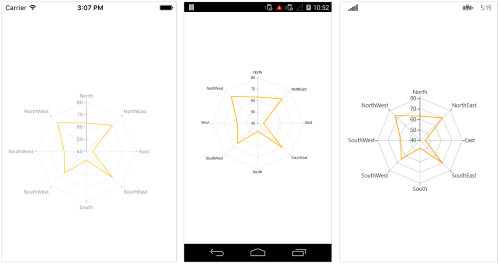
Customize the appearance
You can use the following properties to customize the appearance.
-
Color– used to change the color of the series. -
Opacity- used to control the transparency of the chart series. -
StrokeWidth– used to change the stroke width of the series. -
StrokeColor– used to change the stroke color of the series when draw types is set toArea -
StrokeDashArray– used to render lines with dashes when the draw type is set toLine.
<chart:RadarSeries ItemsSource="{Binding RadarData}" Color="Aqua" StrokeColor="Blue"
StrokeWidth="3" XBindingPath="Name" YBindingPath="Value" />RadarSeries radar = new RadarSeries ();
radar.ItemsSource = viewModel.RadarData;
radar.XBindingPath = "Name";
radar.YBindingPath = "Value";
radar.Color = Color.Aqua;
radar.StrokeColor = Color.Blue;
radar.StrokeWidth = 3;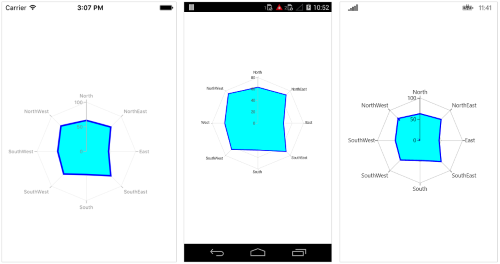
Closed
Closed property is used to determine, whether to connect the first and last data point of the series. By default, the property is set to true.
<chart:RadarSeries ItemsSource="{Binding RadarData}" IsClosed="false"
XBindingPath="Name" YBindingPath="Value" />RadarSeries radar = new RadarSeries ();
radar.ItemsSource = viewModel.RadarData;
radar.XBindingPath = "Name";
radar.YBindingPath = "Value";
radar.IsClosed = false;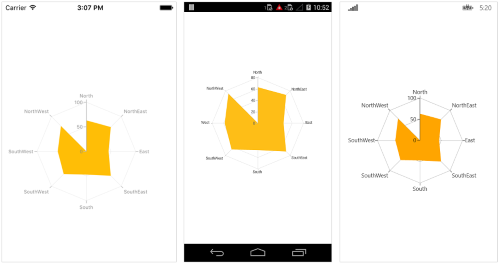
Radar start angle for primary axis
The start position of the radar series can be set by using PolarAngle property of axis. Default value of PolarAngle property is Rotate270. PolarAngle property can be set for primary axis, secondary axis, or both axes
<chart:SfChart.PrimaryAxis>
<chart:CategoryAxis PolarAngle = “Rotate0”/>
</chart:SfChart.PrimaryAxis >
<chart:SfChart.SecondaryAxis>
<chart:NumericalAxis/>
</chart:SfChart.SecondaryAxis >chart.PrimaryAxis = new CategoryAxis(){ PolarAngle = ChartPolarAngle.Rotate0 };
chart.SecondaryAxis = new NumericalAxis();
Radar start angle for secondary axis
<chart:SfChart.PrimaryAxis>
<chart:CategoryAxis/>
</chart:SfChart.PrimaryAxis>
<chart:SfChart.SecondaryAxis>
<chart:NumericalAxis PolarAngle="Rotate0"/>
</chart:SfChart.SecondaryAxis>chart.PrimaryAxis = new CategoryAxis();
chart.SecondaryAxis = new NumericalAxis() { PolarAngle = ChartPolarAngle.Rotate0 };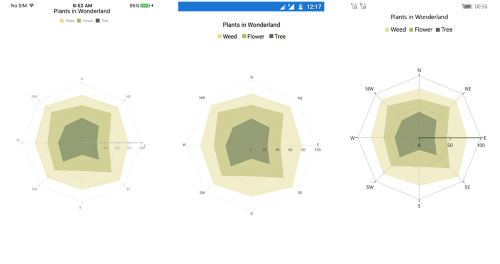
Radar start angle for both axis
<chart:SfChart.PrimaryAxis>
<chart:CategoryAxis PolarAngle = “Rotate0” />
</chart:SfChart.PrimaryAxis>
<chart:SfChart.SecondaryAxis>
<chart:NumericalAxis PolarAngle = “Rotate0” />
</chart:SfChart.SecondaryAxis >chart.PrimaryAxis = new CategoryAxis(){ PolarAngle = ChartPolarAngle.Rotate0 };
chart.SecondaryAxis = new NumericalAxis() { PolarAngle = ChartPolarAngle.Rotate0 };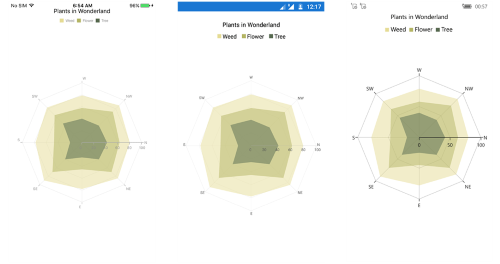
NOTE
You can also explore our Xamarin Radar Chart example to know how to represent time-dependent data, showing trends in data at equal intervals.
Polar Chart
To render a Xamarin Polar chart, create an instance of PolarSeries and add to the Series collection property of SfChart.
Draw type
DrawType property is used to specify the polar series rendering type. Following are the two options you can set to this property,
-
Line– data points are visualized using line series. -
Area– data points are visualized using area series.
<chart:PolarSeries ItemsSource="{Binding PolarData}" DrawType="Line"
XBindingPath="Name" YBindingPath="Value" />PolarSeries polar = new PolarSeries ();
polar.ItemsSource = viewModel.PolarData;
polar.XBindingPath = "Name";
polar.YBindingPath = "Value";
polar.DrawType = PolarRadarSeriesDrawType.Line;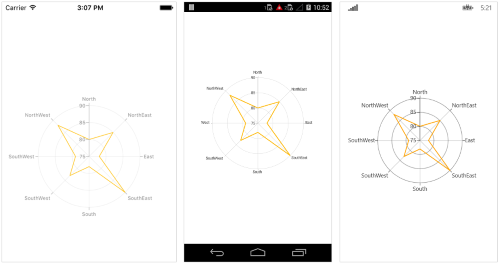
Customize the appearance
You can use the following properties to customize the appearance.
-
Color– used to change the color of the series. -
Opacity- used to control the transparency of the chart series. -
StrokeWidth– used to change the stroke width of the series. -
StrokeColor– used to change the stroke color of the series when draw types is set toArea -
StrokeDashArray– used to render lines with dashes when the draw type is set toLine
<chart:PolarSeries ItemsSource="{Binding PolarData}" StrokeColor="Blue" Color="Aqua"
StrokeWidth="3" XBindingPath="Name" YBindingPath="Value" />PolarSeries polar = new PolarSeries ();
polar.ItemsSource = viewModel.PolarData;
polar.XBindingPath = "Name";
polar.YBindingPath = "Value";
polar.Color = Color.Aqua;
polar.StrokeColor = Color.Blue;
polar.StrokeWidth = 3;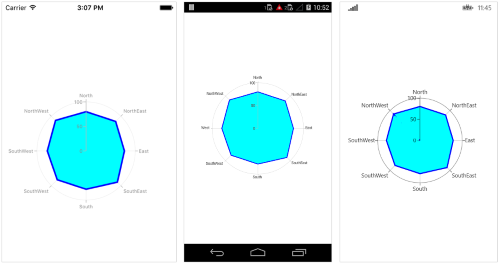
Closed
Closed property is used to determine, whether to connect the first and last data point of the series. By default, the property is set to true.
<chart:PolarSeries ItemsSource="{Binding PolarData}" IsClosed="false"
XBindingPath="Name" YBindingPath="Value" />PolarSeries polar = new PolarSeries ();
polar.ItemsSource = viewModel.PolarData;
polar.XBindingPath = "Name";
polar.YBindingPath = "Value";
polar.IsClosed = false;
Polar start angle for primary axis
The start position of the polar series can be set by using PolarAngle property of axis. Default value of PolarAngle property is Rotate270. PolarAngle property can be set for primary axis, secondary axis, or both axes.
<chart:SfChart.PrimaryAxis>
<chart:CategoryAxis PolarAngle = “Rotate0”/>
</chart:SfChart.PrimaryAxis >
<chart:SfChart.SecondaryAxis>
<chart:NumericalAxis/>
</chart:SfChart.SecondaryAxis >chart.PrimaryAxis = new CategoryAxis(){ PolarAngle = ChartPolarAngle.Rotate0 };
chart.SecondaryAxis = new NumericalAxis();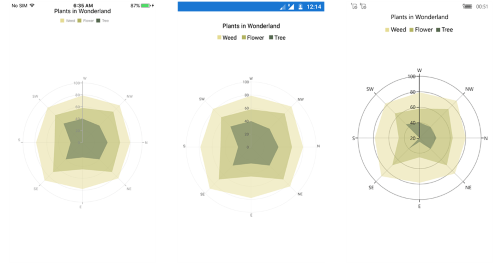
Polar start angle for secondary axis
<chart:SfChart.PrimaryAxis>
<chart:CategoryAxis/>
</chart:SfChart.PrimaryAxis>
<chart:SfChart.SecondaryAxis>
<chart:NumericalAxis PolarAngle="Rotate0"/>
</chart:SfChart.SecondaryAxis>chart.PrimaryAxis = new CategoryAxis();
chart.SecondaryAxis = new NumericalAxis() { PolarAngle = ChartPolarAngle.Rotate0 };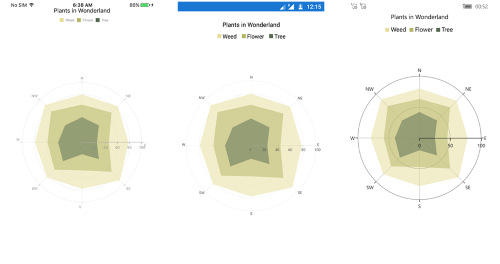
Polar start angle for both axis
<chart:SfChart.PrimaryAxis>
<chart:CategoryAxis PolarAngle = “Rotate0” />
</chart:SfChart.PrimaryAxis >
<chart:SfChart.SecondaryAxis>
<chart:NumericalAxis PolarAngle = “Rotate0” />
</chart:SfChart.SecondaryAxis >chart.PrimaryAxis = new CategoryAxis(){ PolarAngle = ChartPolarAngle.Rotate0 };
chart.SecondaryAxis = new NumericalAxis() { PolarAngle = ChartPolarAngle.Rotate0 };
NOTE
You can also explore our Xamarin Polar Chart example to know how to render and configure the polar line type charts.
Pie Chart
To render a Xamarin Pie chart, create an instance of PieSeries and add to the Series collection property of SfChart. You can use the following properties to customize the pie segment appearance.
-
Color– used to change the color of the series. -
Opacity- used to control the transparency of the chart series. -
StrokeWidth– used to change the stroke width of the series. -
StrokeColor– used to change the stroke color of the series. -
DataMarkerPosition- used to change the position of data marker atInside,OutsideorOutsideExtended. -
ConnectorLinePosition- used to change the position of the connector line atAutoandCenter.
NOTE
ConnectorLinePosition provides better alignment to the straight connector lines with outside extended label position for the minimum number of data points.
<chart:SfChart>
...
<chart:PieSeries ItemsSource ="{Binding Data}" XBindingPath="Expense"
YBindingPath="Value"/>
</chart:SfChart>SfChart chart = new SfChart();
...
PieSeries pieSeries = new PieSeries()
{
ItemsSource = Data,
XBindingPath = "Expense",
YBindingPath = "Value"
};
chart.Series.Add(pieSeries);
NOTE
You can also explore our Xamarin Pie Chart example to know how to render and configure the pie chart.
Changing the pie size
You can use CircularCoefficient property to change the diameter of the pie chart with respect to the plot area. It ranges from 0 to 1 and the default value is 0.8.
<chart:PieSeries CircularCoefficient="0.5"
ItemsSource ="{Binding Data}"
XBindingPath="Expense"
YBindingPath="Value"/>PieSeries pieSeries = new PieSeries()
{
ItemsSource = Data,
XBindingPath = "Expense",
YBindingPath = "Value",
CircularCoefficient = 0.5
};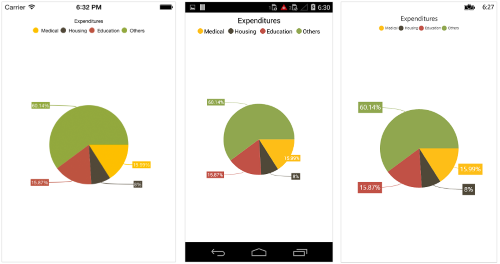
Exploding a pie segment
You can explode a pie segment using ExplodeIndex property and specify the explode radius using ExplodeRadius property of PieSeries.
<chart:PieSeries ExplodeIndex="1"
ItemsSource ="{Binding Data}"
XBindingPath="Expense"
YBindingPath="Value"/>PieSeries pieSeries = new PieSeries()
{
ItemsSource = Data,
XBindingPath = "Expense",
YBindingPath = "Value",
ExplodeIndex = 1
};Also, the segments can be exploded by touch using ExplodeOnTouch property of PieSeries. Default value of this property is false.
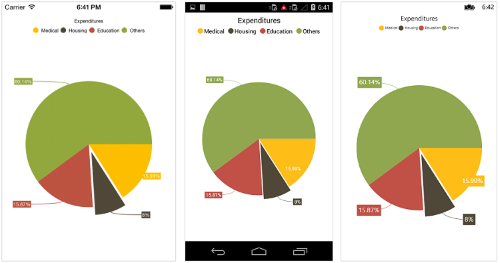
Exploding all the segments
Using ExplodeAll property of PieSeries, you can explode all the pie segments.
<chart:PieSeries ExplodeAll="True" ItemsSource ="{Binding Data}" XBindingPath="Expense"
YBindingPath="Value"/>PieSeries pieSeries = new PieSeries()
{
ItemsSource = Data,
XBindingPath = "Expense",
YBindingPath = "Value",
ExplodeAll = true
};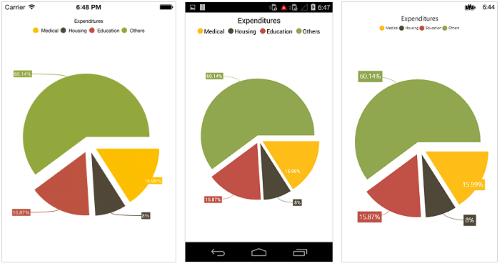
Sector of Pie
SfChart allows you to render all the data points/segments in semi-pie, quarter-pie or in any sector using StartAngle and EndAngle properties.
<chart:PieSeries StartAngle="180"
EndAngle="360"
ItemsSource ="{Binding Data}"
XBindingPath="Expense"
YBindingPath="Value"/>PieSeries pieSeries = new PieSeries()
{
ItemsSource = Data,
XBindingPath = "Expense",
YBindingPath = "Value",
StartAngle = 180,
EndAngle = 360
};
Group small data points into “others”
The small segments in the pie chart can be grouped into “others” category using the GroupTo and GroupMode properties of PieSeries. The GroupMode property is used to specify the grouping type based on slice Angle, actual data point value, or Percentage, and the GroupTo property is used to set the limit to group data points into a single slice. The grouped segment is labeled as “Others” in legend and toggled as any other segment. The default value of the GroupTo property and GroupMode property is Value.
Doughnut Chart
To render a Xamarin Doughnut Chart, create an instance of DoughnutSeries and add to the Series collection property of SfChart. You can use the following properties to customize the doughnut segment appearance.
-
Color– used to change the color of the series. -
Opacity- used to control the transparency of the chart series. -
StrokeWidth– used to change the stroke width of the series. -
StrokeColor– used to change the stroke color of the series. -
DataMarkerPosition- used to change the position of data marker atInside,OutsideorOutsideExtended. -
ConnectorLinePosition- used to change the position of the connector line atAutoandCenter.
NOTE
ConnectorLinePosition provides better alignment to the straight connector lines with outside extended label position for the minimum number of data points.
<chart:SfChart>
...
<chart:DoughnutSeries ItemsSource ="{Binding Data}"
XBindingPath="Expense"
YBindingPath="Value"/>
</chart:SfChart>SfChart chart = new SfChart();
...
DoughnutSeries doughnutSeries = new DoughnutSeries()
{
ItemsSource = Data,
XBindingPath = "Expense",
YBindingPath = "Value"
};
chart.Series.Add(doughnutSeries);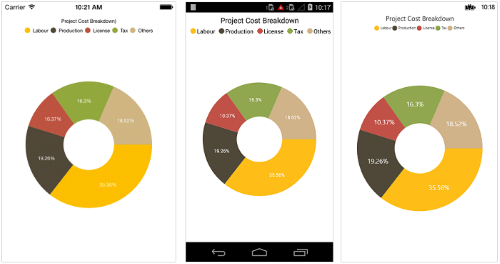
NOTE
You can also explore our Xamarin Doughnut Chart example to knows how to render and configure the donut charts.
Stacked doughnut
Doughnut segments can be separated as individual circles using the IsStackedDoughnut property. The following properties are used to customize the stacked doughnut chart:
-
CapStyle- Specifies the shape of the start and end points of the circular segment. The supported values areBothFlat,BothCurve,StartCurve, andEndCurve. The default value of the this property isBothFlat. -
Spacing- Changes the spacing between two individual segments. The default value of spacing is 0, and the value ranges from 0 to 1. Here, 1 and 0 correspond to 100% and 0% of the available space, respectively. -
MaximumValue- Represents the entire span of an individual circle. The default value of the this property isdouble.NaN. -
TrackColor- Changes the color of the track area. -
TrackBorderColor- Changes the color of the track border. -
TrackBorderWidth- Changes the width of the track border.
<chart:SfChart>
...
<chart:DoughnutSeries ItemsSource ="{Binding Data}"
XBindingPath="Expense"
YBindingPath="Value"
IsStackedDoughnut="true"
CapStyle="BothCurve"
Spacing=”0.4”
MaximumValue=“100” />
</chart:SfChart>SfChart chart = new SfChart();
...
DoughnutSeries doughnutSeries = new DoughnutSeries()
{
ItemsSource = Data,
XBindingPath = "Expense",
YBindingPath = "Value",
IsStackedDoughnut = true,
CapStyle = DoughnutCapStyle.BothCurve,
Spacing = 0.4,
MaximumValue = 100
};
chart.Series.Add(doughnutSeries);
Changing Doughnut inner radius
You can change the doughnut chart inner radius using DoughnutCoefficient with respect to the plot area. It ranges from 0 to 1 and the default value is 0.4.
<chart:DoughnutSeries DoughnutCoefficient="0.6"
ItemsSource ="{Binding Data}"
XBindingPath="Expense"
YBindingPath="Value" />DoughnutSeries doughnutSeries = new DoughnutSeries()
{
ItemsSource = Data,
XBindingPath = "Expense",
YBindingPath = "Value",
DoughnutCoefficient = 0.6
};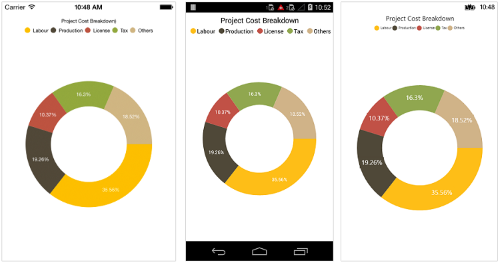
Changing the doughnut size
You can use the CircularCoefficient property to change the diameter of the doughnut chart with respect to the plot area. It ranges from 0 to 1 and the default value is 0.8.
<chart:DoughnutSeries CircularCoefficient="0.5"
ItemsSource ="{Binding Data}"
XBindingPath="Expense"
YBindingPath="Value"/>DoughnutSeries doughnutSeries = new DoughnutSeries()
{
ItemsSource = Data,
XBindingPath = "Expense",
YBindingPath = "Value",
CircularCoefficient = 0.5
};
Exploding a doughnut segment
Exploding a specific doughnut segment, you have to set the index to be exploded using ExplodeIndex property of the series.
<chart:DoughnutSeries ExplodeIndex="1" ItemsSource ="{Binding Data}" XBindingPath="Expense"
YBindingPath="Value" />DoughnutSeries doughnutSeries = new DoughnutSeries()
{
ItemsSource = Data,
XBindingPath = "Expense",
YBindingPath = "Value",
ExplodeIndex = 1
};Also, the segments can be exploded by touch using ExplodeOnTouch property of DoughnutSeries. Default value of this property is false.
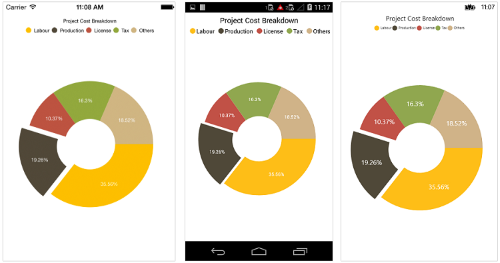
Exploding all the segments
To explode all the segments, you have to enable ExplodeAll property of the series.
<chart:DoughnutSeries ExplodeAll="True" ItemsSource ="{Binding Data}" XBindingPath="Expense"
YBindingPath="Value" />DoughnutSeries doughnutSeries = new DoughnutSeries()
{
ItemsSource = Data,
XBindingPath = "Expense",
YBindingPath = "Value",
ExplodeAll = true
};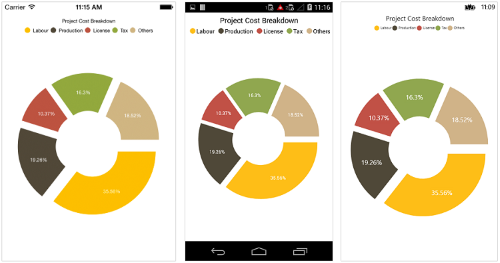
Sector of Doughnut
SfChart allows you to render all the data points/segments in semi-doughnut, quarter- doughnut or in any sector using StartAngle and EndAngle properties.
<chart:DoughnutSeries StartAngle="180" EndAngle="360" ItemsSource ="{Binding Data}"
XBindingPath="Expense" YBindingPath="Value" />DoughnutSeries doughnutSeries = new DoughnutSeries()
{
ItemsSource = Data,
XBindingPath = "Expense",
YBindingPath = "Value",
StartAngle = 180,
EndAngle = 360
};
Group small data points into “others”
The small segments in the doughnut chart can be grouped into “others” category using the GroupTo and GroupMode properties of DoughnutSeries. The GroupMode property is used to specify the grouping type based on slice angle, actual data point value, or percentage, and the GroupTo property is used to set the limit to group data points into a single slice. The grouped segment is labeled as “Others” in legend and toggled as any other segment. The default value of the GroupTo property and GroupMode property is Value.
Add view to the center of doughnut chart
Any view can be added to the center of doughnut chart using the CenterView property of DoughnutSeries. The binding context of the CenterView will be the respective DoughnutSeries.
<chart:DoughnutSeries>
...
<chart:DoughnutSeries.CenterView>
<StackLayout HorizontalOptions = "FillAndExpand"
VerticalOptions = "FillAndExpand">
...
</StackLayout>
</chart:DoughnutSeries.CenterView>
...
</chart:DoughnutSeries>DoughnutSeries doughnutSeries = new DoughnutSeries()
{
...
}
doughnutSeries.CenterView = new Label() { Text = "CenterView" };
InnerRadius
The InnerRadius property of DoughnutSeries is used to get only the inner radius. Using this InnerRadius value, you can provide CentreView for series to avoid the view from being cropped outside the series.
Pyramid Chart
To render a Xamarin Pyramid chart, create an instance of PyramidSeries and add to the Series collection property of SfChart. You can use the following properties to customize the pyramid segment appearance.
-
Color– used to change the color of the series. -
Opacity- used to control the transparency of the chart series. -
StrokeWidth– used to change the stroke width of the series. -
StrokeColor– used to change the stroke color of the series.
<chart:SfChart>
...
<chart:PyramidSeries ItemsSource ="{Binding Data}" XBindingPath="Country"
YBindingPath="Value"/>
</chart:SfChart>SfChart chart = new SfChart();
...
PyramidSeries pyramidSeries = new PyramidSeries()
{
ItemsSource = Data,
XBindingPath = "Country",
YBindingPath = "Value"
};
chart.Series.Add(pyramidSeries);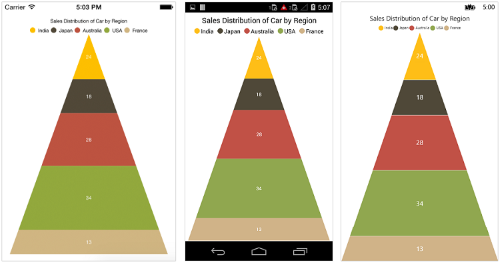
NOTE
. You can also explore our Xamarin Pyramid Chart example to know how to render a pyramid series.
Pyramid Mode
You can render the pyramid series as linear or surface mode. In linear mode, height of the pyramid segment is based on the Y value and in surface mode, area of the pyramid segment is based on the Y values. The default value of PyramidMode property is Linear.
<chart:PyramidSeries ItemsSource ="{Binding Data}" PyramidMode="Surface" XBindingPath="Country"
YBindingPath="Value"/>PyramidSeries pyramidSeries = new PyramidSeries ()
{
ItemsSource = Data,
XBindingPath = "Country",
YBindingPath = "Value",
PyramidMode = ChartPyramidMode.Surface
};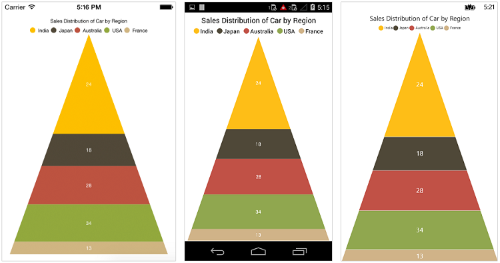
Gap between the segments
You can control the gap between the two segments using GapRatio property. Its ranges from 0 to 1.
<chart:PyramidSeries ItemsSource ="{Binding Data}" GapRatio="0.1"
XBindingPath="Country"
YBindingPath="Value"/>PyramidSeries pyramidSeries = new PyramidSeries()
{
ItemsSource = Data,
XBindingPath = "Country",
YBindingPath = "Value",
GapRatio = 0.1
};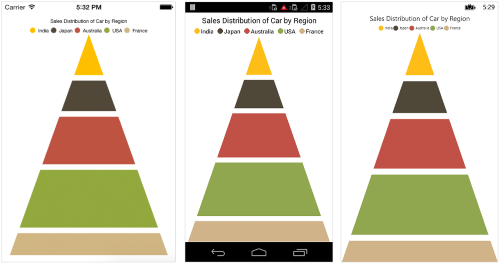
Exploding a pyramid segment
You can explode a pyramid segment using ExplodeIndex property, and ExplodeOffset property is used to specify the exploded segment’s distance.
<chart:PyramidSeries ItemsSource ="{Binding Data}" ExplodeIndex="2"
XBindingPath="Country"
YBindingPath="Value" />PyramidSeries pyramidSeries = new PyramidSeries()
{
ItemsSource = Data,
XBindingPath = "Country",
YBindingPath = "Value",
ExplodeIndex = 2
};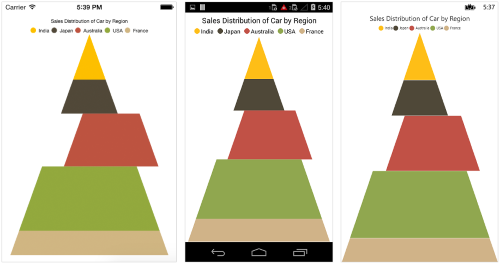
Funnel Chart
To render a Xamarin Funnel Chart, create an instance of FunnelSeries and add to the Series collection property of SfChart. You can use the following properties to customize the funnel segment appearance.
-
Color– used to change the color of the series. -
Opacity- used to control the transparency of the chart series. -
StrokeWidth– used to change the stroke width of the series. -
StrokeColor– used to change the stroke color of the series.
<chart:SfChart>
...
<chart:FunnelSeries ItemsSource ="{Binding Data}" XBindingPath="Status"
YBindingPath="Value"/>
</chart:SfChart>SfChart chart = new SfChart();
...
FunnelSeries funnelSeries = new FunnelSeries()
{
ItemsSource = Data,
XBindingPath = "Status",
YBindingPath = "Value"
};
chart.Series.Add(funnelSeries);
NOTE
You can also explore our Xamarin Funnel Chart example to knows how to render and configure the funnel chart.
Gap between the segments
You can control the gap between the two segments using GapRatio property. Its ranges from 0 to 1.
<chart:FunnelSeries ItemsSource ="{Binding Data}" GapRatio="0.1"
XBindingPath="Year"
YBindingPath="Value"/>FunnelSeries funnelSeries = new FunnelSeries()
{
ItemsSource = Data,
XBindingPath = "Year",
YBindingPath = "Value",
GapRatio = 0.1
};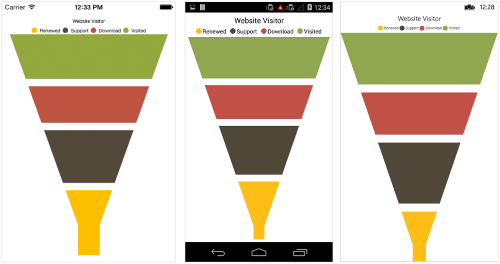
Exploding a funnel segment
You can explode a pyramid segment using ExplodeIndex property and ExplodeOffset property is used to specify the exploded segment’s distance.
<chart:FunnelSeries ItemsSource ="{Binding Data}" ExplodeIndex="1"
XBindingPath="Status"
YBindingPath="Value" />FunnelSeries funnelSeries = new FunnelSeries()
{
ItemsSource = Data,
XBindingPath = "Status",
YBindingPath = "Value",
ExplodeIndex = 1
};Also, the segments can be exploded by touch using ExplodeOnTouch property of FunnelSeries. Default value of this property is false.
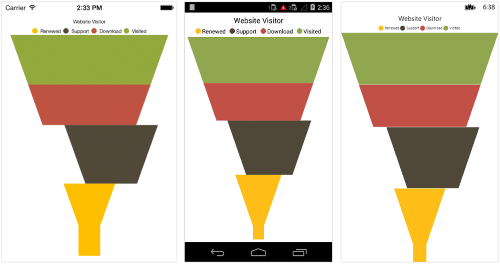
Changing the minimum width of the funnel
You can change the minimum width of the funnel neck using MinWidth property of FunnelSeries. Default value of minWidth is 40.
<chart:FunnelSeries ItemsSource ="{Binding Data}" MinWidth="20"
XBindingPath="Year"
YBindingPath="Value"/>FunnelSeries funnelSeries = new FunnelSeries()
{
ItemsSource = Data,
XBindingPath = "Year",
YBindingPath = "Value",
MinWidth = 20
};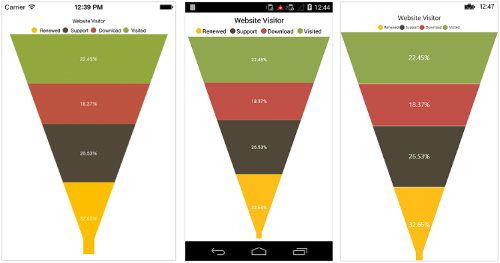
Waterfall Chart
WaterfallSeries clarifies the cumulative effect of a set of provided positive and negative values. The series is represented by a rectangle and a connector between the rectangles.
-
SummaryBindingPath– Gets or sets the string value that indicates the sum of previous segments in series. -
SummarySegmentColor– Changes the color of summary segment in series. -
NegativeSegmentColor– Changes the color of negative segment in series. -
AllowAutoSum– Enables or disables the segment that has been drawn based on the sum value of previous segments. By default, the value of this property is true. When disabling this property, it renders the segment by using the y-value of provided ItemsSource collection. -
ShowConnectorLine– Enables or disables the connector line of series. By default, value of this property is true. -
ConnectorLineStyle– Customizes the appearance of connector line style.
<chart:WaterfallSeries ItemsSource="{Binding RevenueDetails}"
XBindingPath="Category"
YBindingPath="Value"
AllowAutoSum="True"
SummaryBindingPath="IsSummary"
NegativeSegmentColor="#F14C72"
SummarySegmentColor="#8C8C8C"
ShowConnectorLine="True">
</chart:WaterfallSeries>WaterfallSeries waterfallSeries = new WaterfallSeries()
{
ItemsSource = RevenueDetails,
XBindingPath = "Category",
YBindingPath = "Value",
AllowAutoSum = true,
SummaryBindingPath = "IsSummary",
NegativeSegmentColor = Color.FromHex("#F14C72"),
SummarySegmentColor = Color.FromHex("#8C8C8C"),
ShowConnectorLine = true
};
chart.Series.Add(waterfallSeries);
Box and Whisker Chart
BoxAndWhiskerSeries plots a combination of rectangles and lines to show the distribution of data sets. To render a box and whisker(box plot) chart, create an instance of BoxAndWhiskerSeries and add to the Series collection property of SfChart. You can use the following properties to customize the appearance.
-
Color- used to change the color of the series. -
StrokeWidth- used to change the stroke width of the series. -
StrokeColor- used to change the stroke color of the series. -
Spacing- used to change the spacing between two segments. The default value of spacing is 0, and the value ranges from 0 to 1. Here, 1 and 0 corresponds to 100% and 0% of the available space, respectively. -
Width- used to change the width of the rectangle. The default value of the width is 0.8, and the value ranges from 0 to 1. Here, 1 and 0 corresponds to 100% and 0% of the available width, respectively.
<chart:SfChart>
...
<chart:BoxAndWhiskerSeries ItemSource ="{Binding Data"} XBindingPath="Department"
YBindingPath="Ages"
ShowMedian="True" />
</chart:SfChart>SfChart chart = new SfChart();
...
BoxAndWhiskerSeries boxPlotSeries = new BoxAndWhiskerSeries()
{
ItemsSource = Data,
XBindingPath = "Department",
YBindingPath = "Ages",
ShowMedian = true;
};
chart.Series.Add(boxPlotSeries);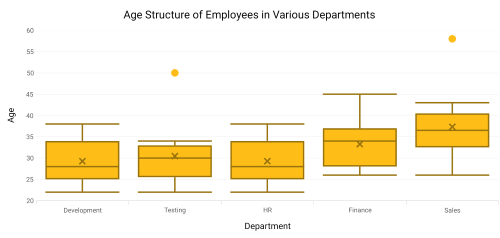
Customize the series box mode
The series box plotting mode can be changed using the BoxPlotMode property of BoxAndWhiskerSeries. The plotting mode of series can be calculated as follows:
-
Exclusive- The quartile values are calculated using the formula (N+1) * P (N count, P percentile), and their index value starts from 1 in the list. -
Inclusive- The quartile values are calculated using the formula (N−1) * P (N count, P percentile), and their index value starts from 0 in the list. -
Normal- The quartile values are calculated by splitting the list and getting the median values.
By default, BoxPlotMode value is Exclusive.
The following code shows how to set the BoxPlotMode value as Inclusive.
<chart:SfChart>
...
<chart:BoxAndWhiskerSeries ItemSource ="{Binding Data"} XBindingPath="Department"
YBindingPath="Ages"
BoxPlotMode="Inclusive"
ShowMedian="True" />
</chart:SfChart>SfChart chart = new SfChart();
...
BoxAndWhiskerSeries boxPlotSeries = new BoxAndWhiskerSeries()
{
ItemsSource = Data,
XBindingPath = "Department",
YBindingPath = "Ages",
BoxPlotMode = BoxPlotMode.Inclusive,
ShowMedian = true
};
chart.Series.Add(boxPlotSeries);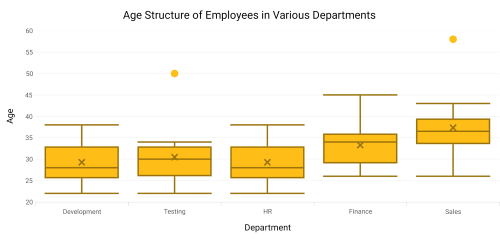
ShowMedian
The Median values of given data set is viewed by enabling the ShowMedian property of BoxAndWhiskerSeries. By default,ShowMedian value is false. The following code demonstrates how to enable the ShowMedian property.
<chart:SfChart>
...
<chart:BoxAndWhiskerSeries ItemSource ="{Binding Data"} XBindingPath="Department"
YBindingPath="Ages"
ShowMedian="True" />
</chart:SfChart>SfChart chart = new SfChart();
...
BoxAndWhiskerSeries boxPlotSeries = new BoxAndWhiskerSeries()
{
ItemsSource = Data,
XBindingPath = "Department",
YBindingPath = "Ages",
ShowMedian = true
}
chart.Series.Add(boxPlotSeries);
Outlier
The outlier is used to display the outlier point that lies either below the lower whisker or above the upper whisker line and it is an observation that is numerically distant from the rest of the data.
ShowOutlier
The outlier value in the box plot can be viewed by enabling the ShowOutlier property of BoxAndWhiskerSeries. By default, ShowOutlier value is true. The following code demonstrates how to disable the ShowOutlier property.
<chart:SfChart>
...
<chart:BoxAndWhiskerSeries ItemSource ="{Binding Data"} XBindingPath="Department"
YBindingPath="Ages"
ShowMedian="True"
ShowOutlier="False" />
</chart:SfChart>SfChart chart = new SfChart();
...
BoxAndWhiskerSeries boxPlotSeries = new BoxAndWhiskerSeries()
{
ItemsSource = Data,
XBindingPath = "Department",
YBindingPath = "Ages",
ShowMedian = true,
ShowOutlier = false
}
chart.Series.Add(boxPlotSeries);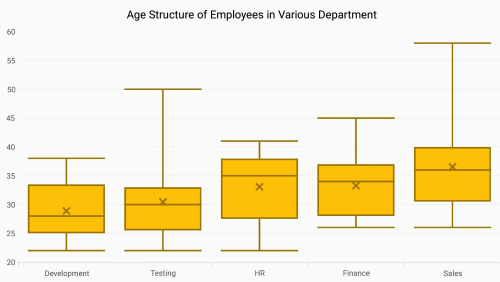
SymbolType
The SymbolType is used to display the outlier point with different types of symbols. The available symbols are Cross, Diamond, Ellipse, Hexagon, InvertedTriangle, Pentagon, Plus, Rectangle and Triangle. By default, SymbolType value is Ellipse.
The following code shows how to set the SymbolType value as Cross.
<chart:SfChart>
...
<chart:BoxAndWhiskerSeries ItemSource ="{Binding Data"} XBindingPath="Department"
YBindingPath="Ages"
ShowMedian="True"
SymbolType="Cross" />
</chart:SfChart>SfChart chart = new SfChart();
...
BoxAndWhiskerSeries boxPlotSeries = new BoxAndWhiskerSeries()
{
ItemsSource = Data,
XBindingPath = "Department",
YBindingPath = "Ages",
ShowMedian = true,
SymbolType = ChartSymbolType.Cross
}
chart.Series.Add(boxPlotSeries);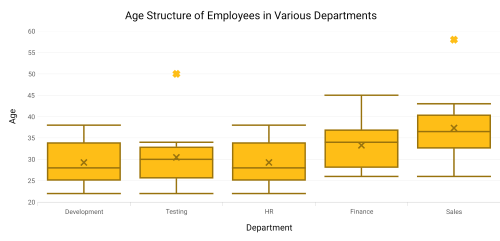
Error Bar Chart
ErrorBarSeries is graphical representations of the variations of data and used on graphs to indicate the errors or uncertainty in a reported measurement. To render a error bar chart, create an instance of ErrorBarSeries and add to the Series collection property of SfChart.
<chart:SfChart>
...
<chart:ScatterSeries ScatterHeight="20"
ScatterWidth="20"
ShapeType="Ellipse"
ItemsSource ="{Binding CarDistributionDetails}"
XBindingPath="Country"
YBindingPath="Value">
<chart:ScatterSeries.ColorModel>
<chart:ChartColorModel Palette="Natural"/>
</chart:ScatterSeries.ColorModel>
</chart:ScatterSeries>
<chart:ErrorBarSeries ItemsSource = "{Binding CarDistributionDetails}"
XBindingPath = "Country"
YBindingPath = "Value"
Type = ErrorBarType.Fixed
Mode = ErrorBarMode.Both
HorizontalErrorValue = 0.5
VerticalErrorValue = 4/>
</chart:SfChart>SfChart chart = new SfChart();
...
ScatterSeries scatterSeries = new ScatterSeries ()
{
ItemsSource = Data,
ScatterHeight = 20,
ScatterWidth = 20,
ShapeType = ChartScatterShapeType.Ellipse,
XBindingPath = "Year",
YBindingPath = "Value"
};
scatterSeries.ColorModel.Palette = ChartColorPalette.Natural;
chart.Series.Add(scatterSeries);
ErrorBarSeries errorBarSeries = new ErrorBarSeries()
{
ItemsSource = CarDistributionDetails,
XBindingPath = "Country",
YBindingPath = "Value",
Type = ErrorBarType.Fixed,
Mode = ErrorBarMode.Both,
HorizontalErrorValue = 0.5,
VerticalErrorValue = 4
};
chart.Series.Add(errorBarSeries);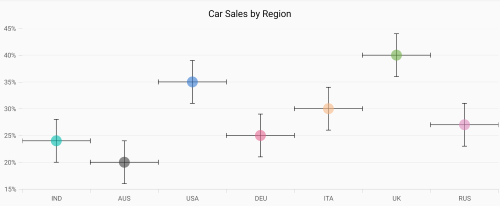
Type
The Type property is used to define the error bar type value in Fixed, Custom, Percentage, StandardDeviation, and StandardErrors. The default value of this property is Fixed. For all types, You have to set the values for HorizontalErrorValue and VerticalErrorValue except Custom.
Fixed
<chart:SfChart>
...
<chart:ErrorBarSeries ItemsSource = "{Binding CarDistributionDetails}"
XBindingPath = "Country"
YBindingPath = "Value"
Type = ErrorBarType.Fixed
Mode = ErrorBarMode.Both
HorizontalErrorValue = 0.5
VerticalErrorValue = 4/>
</chart:SfChart>ErrorBarSeries errorBarSeries = new ErrorBarSeries()
{
ItemsSource = CarDistributionDetails,
XBindingPath = "Country",
YBindingPath = "Value",
Type = ErrorBarType.Fixed,
Mode = ErrorBarMode.Both,
HorizontalErrorValue = 0.5,
VerticalErrorValue = 4
};
Percentage
<chart:SfChart>
...
<chart:ErrorBarSeries ItemsSource = {Binding CarDistributionDetails}"
XBindingPath = "Country"
YBindingPath = "Value"
Type = ErrorBarType.Percentage
Mode = ErrorBarMode.Both
HorizontalErrorValue = 1
VerticalErrorValue = 8/>
</chart:SfChart>ErrorBarSeries errorBarSeries = new ErrorBarSeries()
{
ItemsSource = CarDistributionDetails,
XBindingPath = "Country",
YBindingPath = "Value",
Type = ErrorBarType.Percentage,
Mode = ErrorBarMode.Both,
HorizontalErrorValue = 1,
VerticalErrorValue = 8
};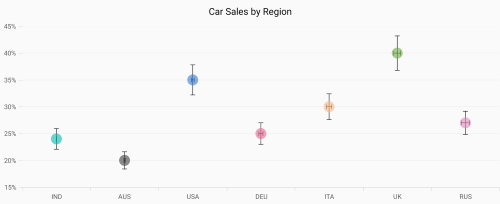
Standard Deviation
<chart:SfChart>
...
<chart:ErrorBarSeries ItemsSource = "{Binding CarDistributionDetails}"
XBindingPath = "Country"
YBindingPath = "Value"
Type = ErrorBarType.StandardDeviation
Mode = ErrorBarMode.Both
HorizontalErrorValue = 1
VerticalErrorValue = 4/>
</chart:SfChart>ErrorBarSeries errorBarSeries = new ErrorBarSeries()
{
ItemsSource = CarDistributionDetails,
XBindingPath = "Country",
YBindingPath = "Value",
Type = ErrorBarType.StandardDeviation,
Mode = ErrorBarMode.Both,
HorizontalErrorValue = 1,
VerticalErrorValue = 4
};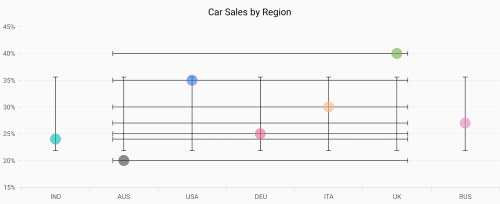
Standard Errors
<chart:SfChart>
...
<chart:ErrorBarSeries ItemsSource = "{Binding CarDistributionDetails}"
XBindingPath = "Country"
YBindingPath = "Value"
Type = ErrorBarType.StandardErrors
Mode = ErrorBarMode.Both
HorizontalErrorValue = 1
VerticalErrorValue = 4/>
</chart:SfChart>ErrorBarSeries errorBarSeries = new ErrorBarSeries()
{
ItemsSource = CarDistributionDetails,
XBindingPath = "Country",
YBindingPath = "Value",
Type = ErrorBarType.StandardErrors,
Mode = ErrorBarMode.Both,
HorizontalErrorValue = 1,
VerticalErrorValue = 4
};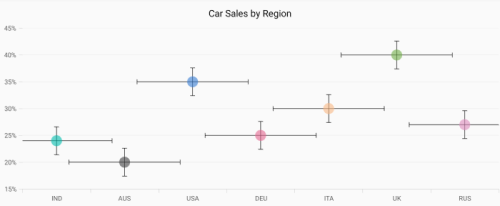
Custom
If Type is Custom, you have to set values for HorizontalErrorPath and VerticalErrorPath as shown in the following code snippet.
<chart:SfChart>
...
<chart:ErrorBarSeries ItemsSource = "{Binding CarDistributionDetails}"
XBindingPath = "Country"
YBindingPath = "Value"
Type=ErrorBarType.Custom
Mode = ErrorBarMode.Both
HorizontalErrorPath = "HorizontalErrorValues"
VerticalErrorPath = "VerticalErrorValues"/>
</chart:SfChart>ErrorBarSeries errorBarSeries = new ErrorBarSeries()
{
ItemsSource = CarDistributionDetails,
XBindingPath = "Country",
YBindingPath = "Value",
Type = ErrorBarType.Custom,
Mode = ErrorBarMode.Both,
HorizontalErrorPath = "HorizontalErrorValues",
VerticalErrorValue = "VerticalErrorValues"
};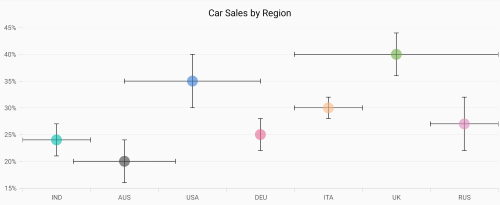
Mode
The error value shown on the chart is based on the Mode property. It have the values of Both, Horizontal, and Vertical. The default value of this property is Both.
Both
To display horizontal and vertical error values, you can set the Mode as Both as shown in the following code.
<chart:SfChart>
...
<chart:ErrorBarSeries ItemsSource="{Binding CarDistributionDetails}"
XBindingPath = "Country"
YBindingPath = "Value"
Type = ErrorBarType.Fixed
Mode = ErrorBarMode.Both
HorizontalErrorValue = 0.5
VerticalErrorValue = 4/>
</chart:SfChart>ErrorBarSeries errorBarSeries = new ErrorBarSeries()
{
ItemsSource = CarDistributionDetails,
XBindingPath = "Country",
YBindingPath = "Value",
Type = ErrorBarType.Fixed,
Mode = ErrorBarMode.Horizontal,
HorizontalErrorValue = 0.5,
VerticalErrorValue = 4
};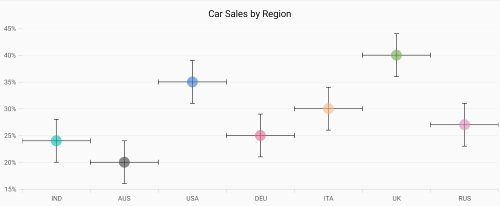
Horizontal
To display horizontal error value only, you can set the Mode as Horizontal as shown in the following code.
<chart:SfChart>
...
<chart:ErrorBarSeries ItemsSource="{Binding CarDistributionDetails}"
XBindingPath = "Country"
YBindingPath = "Value"
Type = ErrorBarType.Fixed
Mode = ErrorBarMode.Horizontal
HorizontalErrorValue = 0.5
VerticalErrorValue = 4/>
</chart:SfChart>ErrorBarSeries errorBarSeries = new ErrorBarSeries()
{
ItemsSource = CarDistributionDetails,
XBindingPath = "Country",
YBindingPath = "Value",
Type = ErrorBarType.Fixed,
Mode = ErrorBarMode.Horizontal,
HorizontalErrorValue = 0.5,
VerticalErrorValue = 4
};
Vertical
To display vertical error value only, you can set the Mode as Vertical as shown in the following code.
<chart:SfChart>
...
<chart:ErrorBarSeries ItemsSource="{Binding CarDistributionDetails}"
XBindingPath = "Country"
YBindingPath = "Value"
Type = ErrorBarType.Fixed
Mode = ErrorBarMode.Vertical
HorizontalErrorValue = 0.5
VerticalErrorValue = 4/>
</chart:SfChart>ErrorBarSeries errorBarSeries = new ErrorBarSeries()
{
ItemsSource = CarDistributionDetails,
XBindingPath = "Country",
YBindingPath = "Value",
Type = ErrorBarType.Fixed,
Mode = ErrorBarMode.Vertical,
HorizontalErrorValue = 0.5,
VerticalErrorValue = 4
};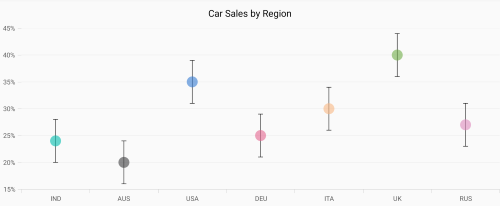
Direction
The HorizontalDirection and VerticalDirection properties are used to set the direction of error bar lines. The default value is Both.
-
Both- used to set error value in positive and negative directions. -
Minus- used to set error value in a negative direction. -
Plus- used to set error value in a positive direction.
<chart:SfChart>
...
<chart:ErrorBarSeries ItemsSource = "{Binding CarDistributionDetails}"
XBindingPath = "Country"
YBindingPath = "Value"
HorizontalDirection = ErrorBarDirection.Plus
VerticalDirection = ErrorBarDirection.Minus
HorizontalErrorValue = 0.5
VerticalErrorValue = 4/>
</chart:SfChart>ErrorBarSeries errorBarSeries = new ErrorBarSeries()
{
ItemsSource = CarDistributionDetails,
XBindingPath = "Country",
YBindingPath = "Value",
HorizontalDirection = ErrorBarDirection.Plus,
VerticalDirection = ErrorBarDirection.Minus,
HorizontalErrorValue = 0.5,
VerticalErrorValue = 4
};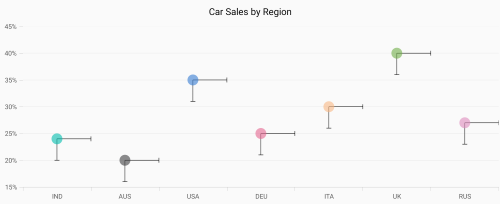
Customization
You can customize the ErrorBarSeries with the following style properties.
-
HorizontalLineStyle– used to customize the appearance of horizontal error bar line. -
VerticalLineStyle– used to customize the appearance of vertical error bar line. -
HorizontalCapLineStyle– used to customize the appearance of horizontal error bar cap line. -
VerticalCapLineStyle– used to customize the appearance of vertical error bar cap line.
<chart:SfChart>
...
<chart:ErrorBarSeries.HorizontalLineStyle>
<chart:ErrorBarLineStyle
StrokeColor= "Cyan"
StrokeWidth = "4">
</chart:ErrorBarSeries.HorizontalLineStyle>
<chart:ErrorBarSeries.VerticalLineStyle>
<chart:ErrorBarLineStyle
StrokeColor = "Cyan"
StrokeWidth = "4">
</chart:ErrorBarSeries.VerticalLineStyle>
<chart:ErrorBarSeries.HorizontalCapLineStyle>
<chart:ErrorBarCapLineStyle
StrokeColor= "Green"
StrokeWidth= "4"
IsVisible = "true">
</chart:ErrorBarSeries.HorizontalCapLineStyle>
<chart:ErrorBarSeries.VerticalCapLineStyle>
<chart:ErrorBarCapLineStyle
StrokeColor = "Green"
StrokeWidth = "4"
IsVisible = "true">
</chart:ErrorBarSeries.VerticalCapLineStyle>
</chart:SfChart>errorBarSeries.HorizontalLineStyle = new ErrorBarLineStyle();
errorBarSeries.HorizontalLineStyle.StrokeColor = Color.Cyan;
errorBarSeries.HorizontalLineStyle.StrokeWidth = 4;
errorBarSeries.VerticalLineStyle = new ErrorBarLineStyle();
errorBarSeries.VerticalLineStyle.StrokeColor = Color.Cyan;
errorBarSeries.VerticalLineStyle.StrokeWidth = 4;
errorBarSeries.HorizontalCapLineStyle = new ErrorBarCapLineStyle();
errorBarSeries.HorizontalCapLineStyle.StrokeColor = Color.Green;
errorBarSeries.HorizontalCapLineStyle.StrokeWidth = 4;
errorBarSeries.HorizontalCapLineStyle.IsVisible = true;
errorBarSeries.VerticalCapLineStyle = new ErrorBarCapLineStyle();
errorBarSeries.VerticalCapLineStyle.StrokeColor = Color.Green;
errorBarSeries.VerticalCapLineStyle.StrokeWidth = 4;
errorBarSeries.VerticalCapLineStyle.IsVisible = true;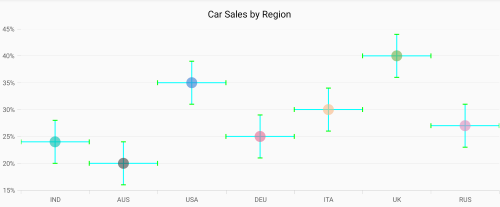
NOTE
You can refer to our Xamarin Charts feature tour page for its groundbreaking feature representations. You can also explore our Xamarin.Forms Charts example to knows various chart types and how to easily configured with built-in support for creating stunning visual effects.
See also
How to draw dotted line using FastLineSeries in Chart
How to visualize the Xamarin.Forms Pie Chart in linear form
How to achieve the Tornado chart in Xamarin.Forms Chart
How to use the drill-down functionality in Xamarin.Forms Chart